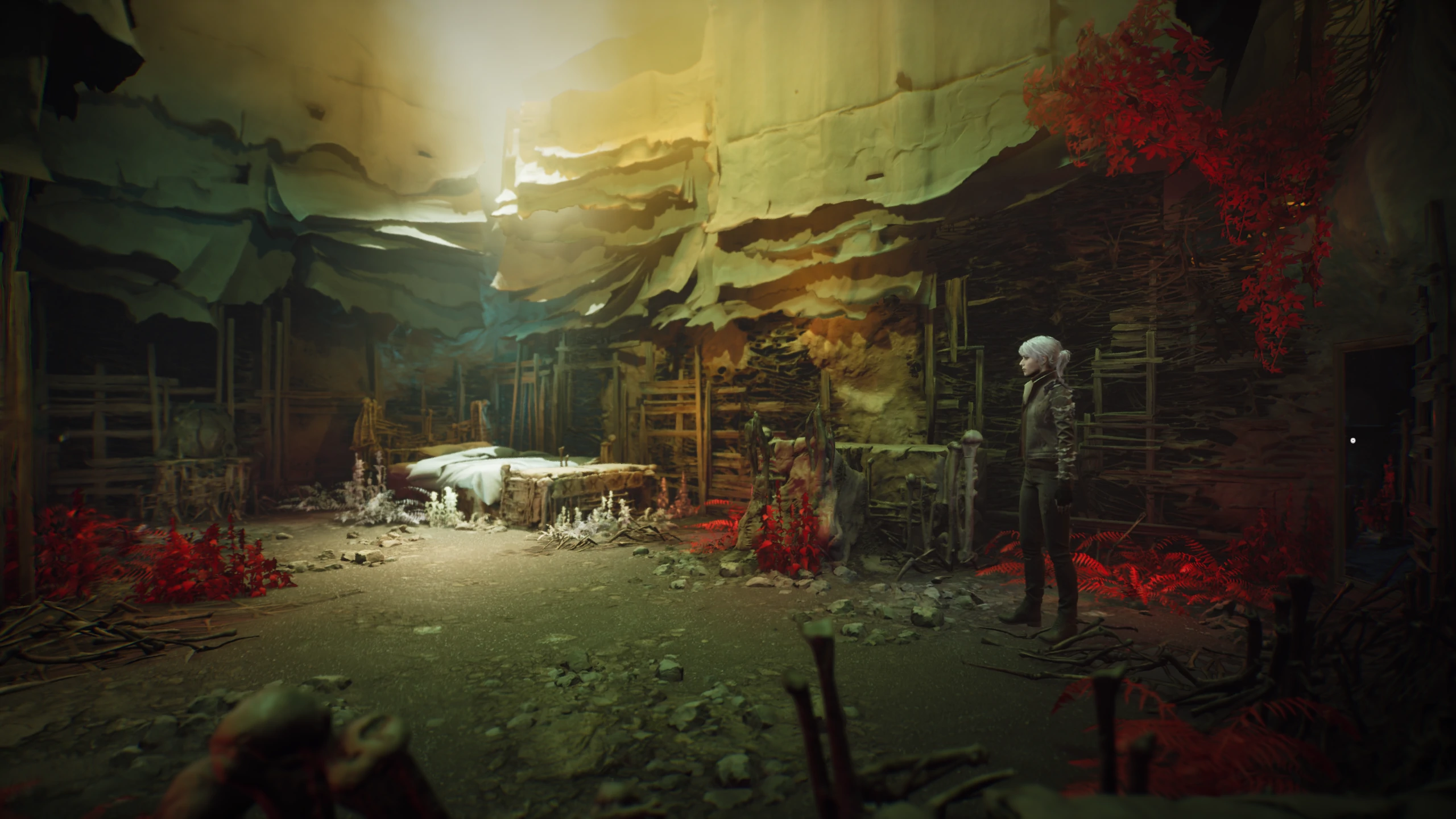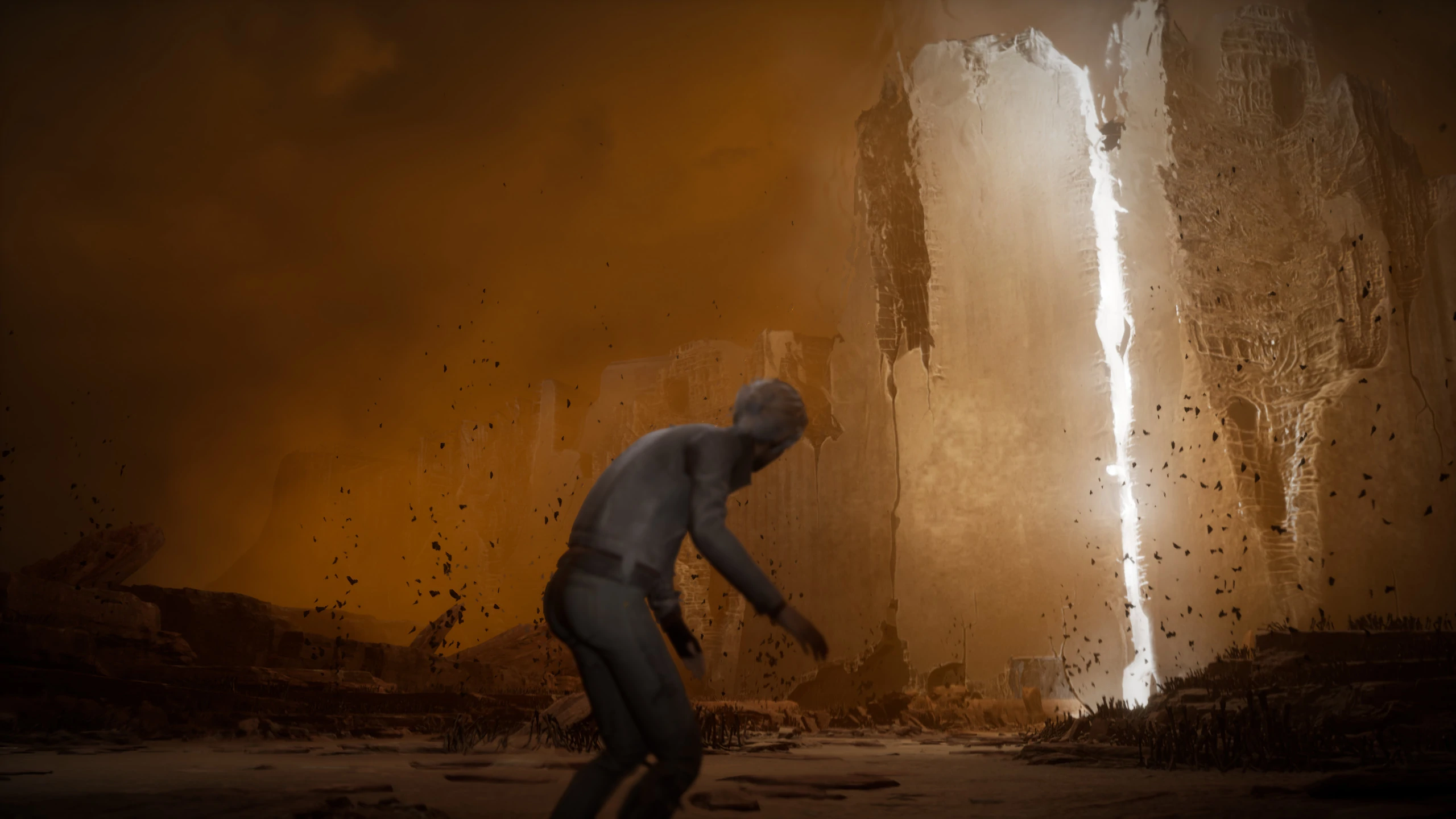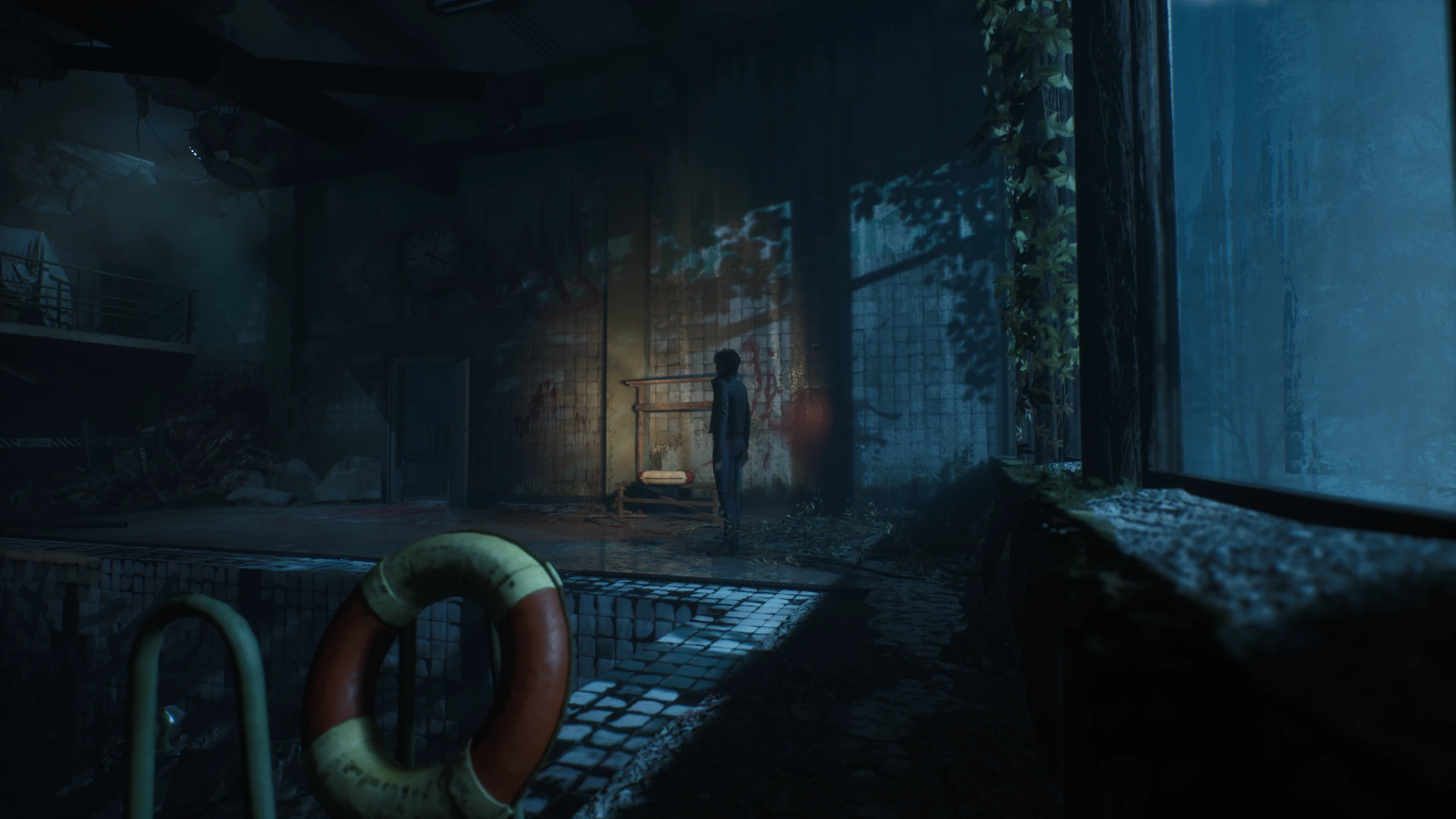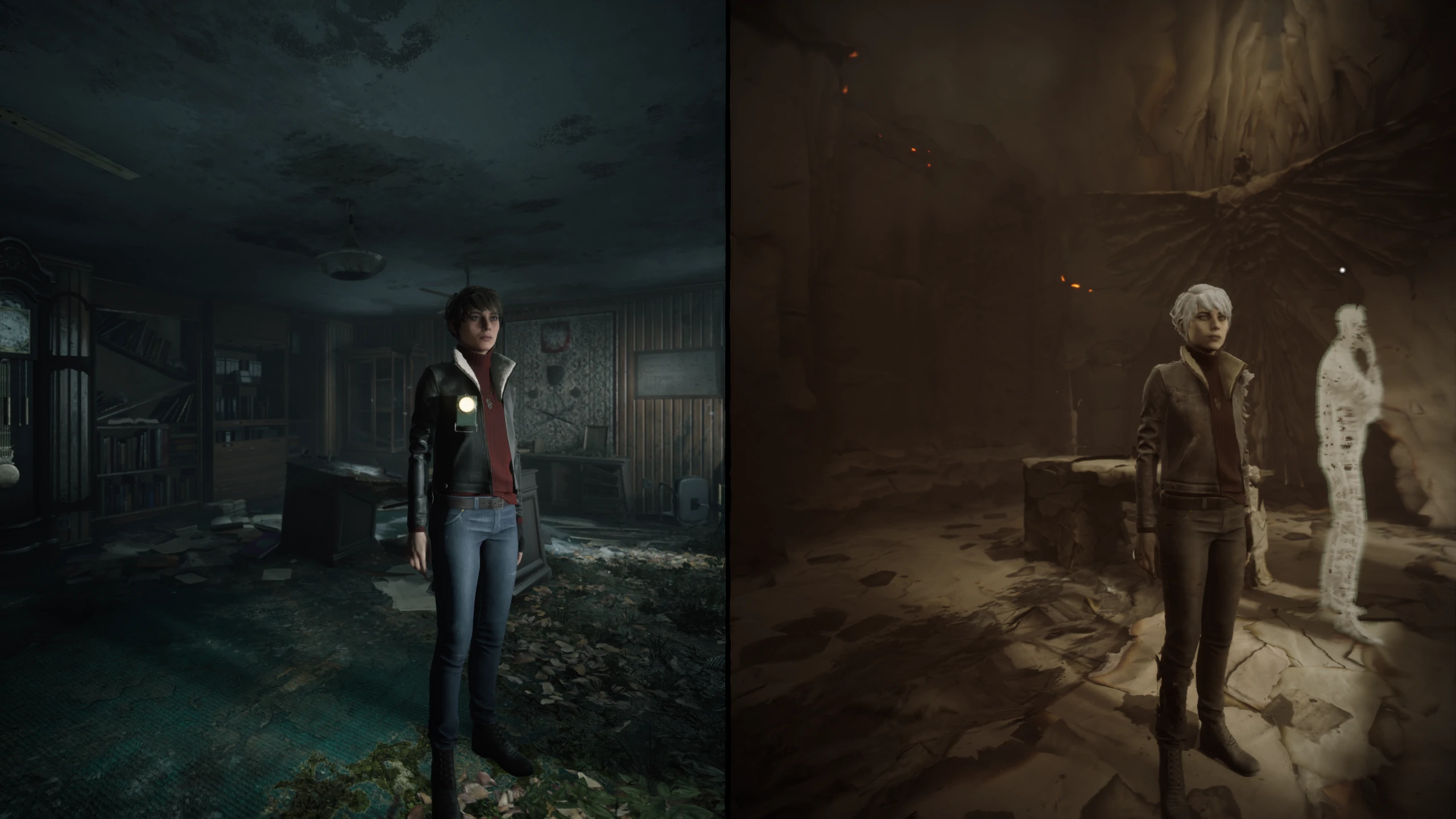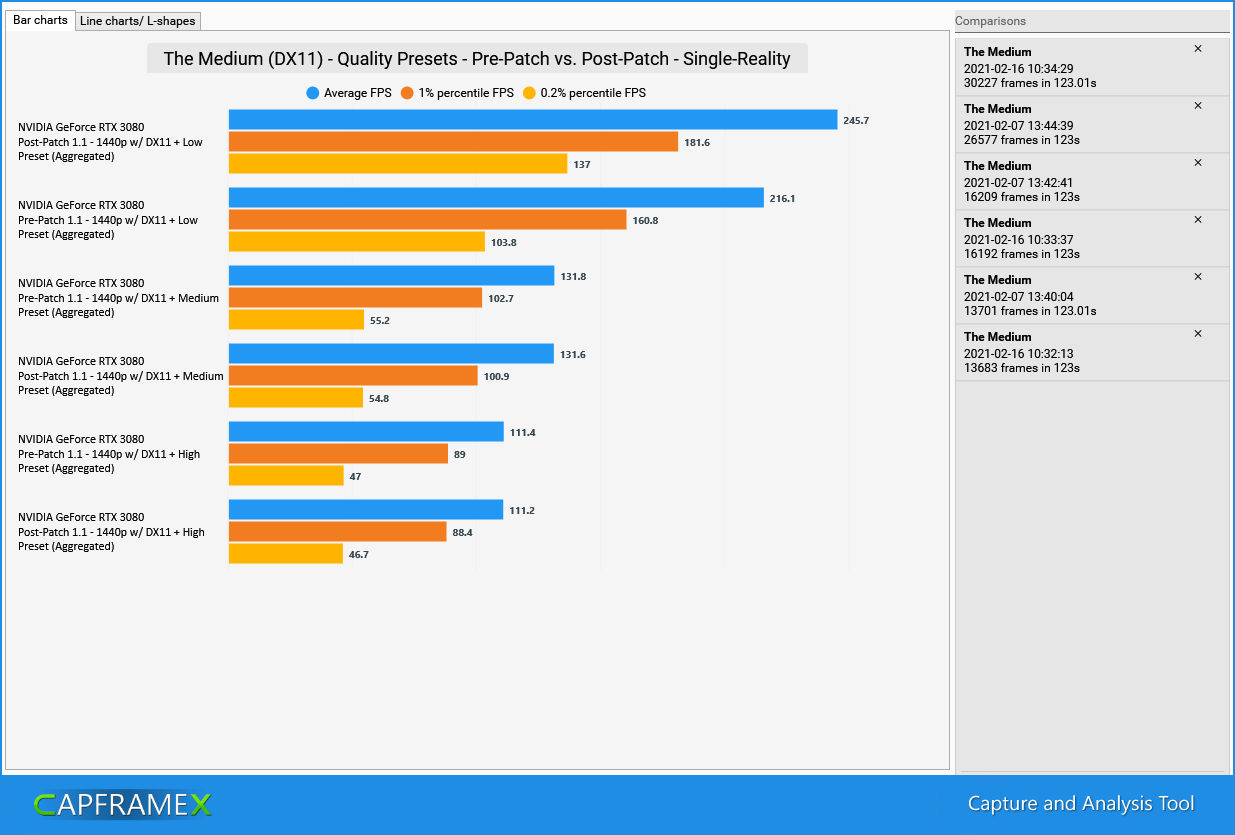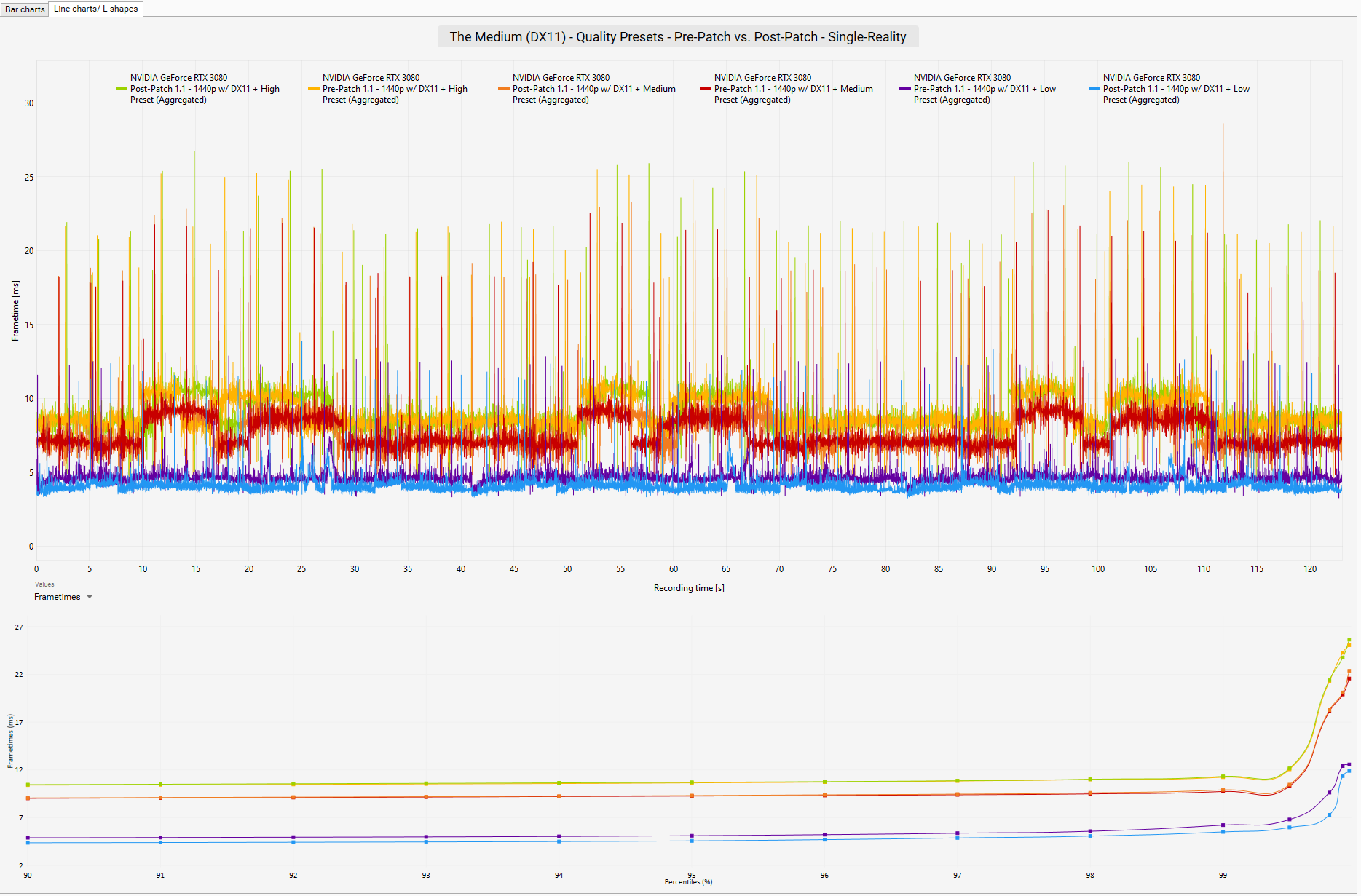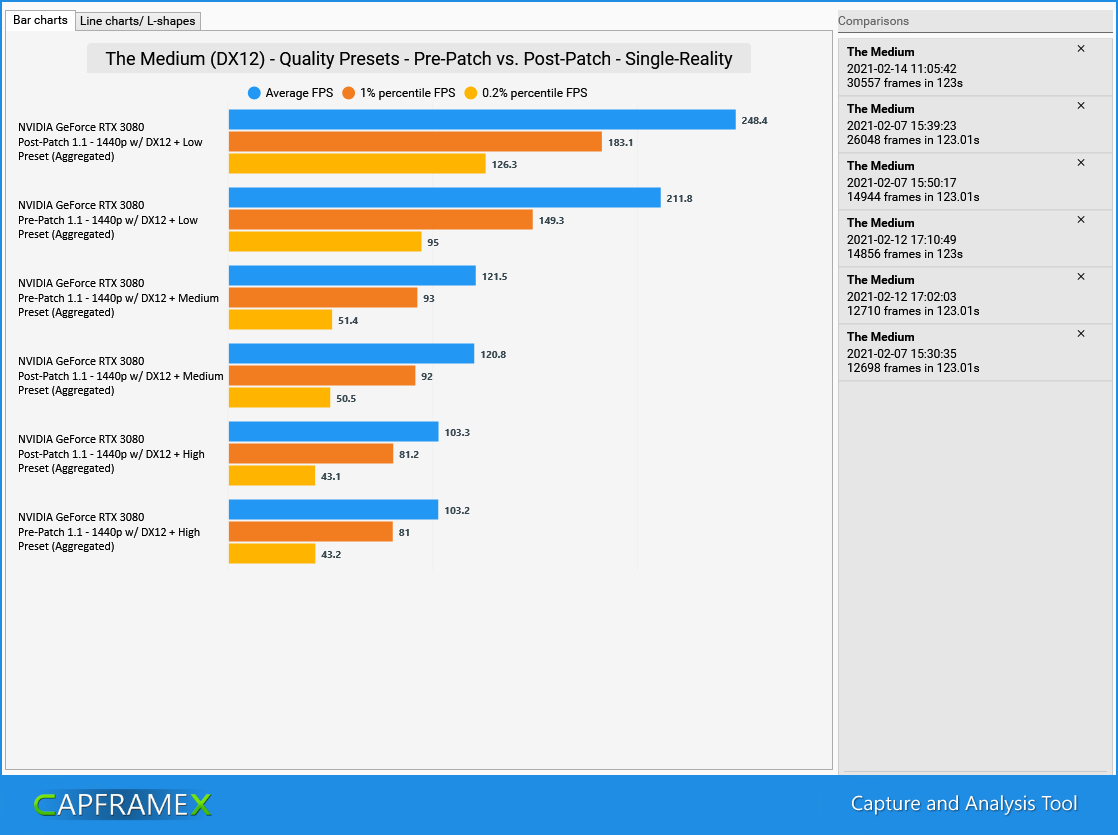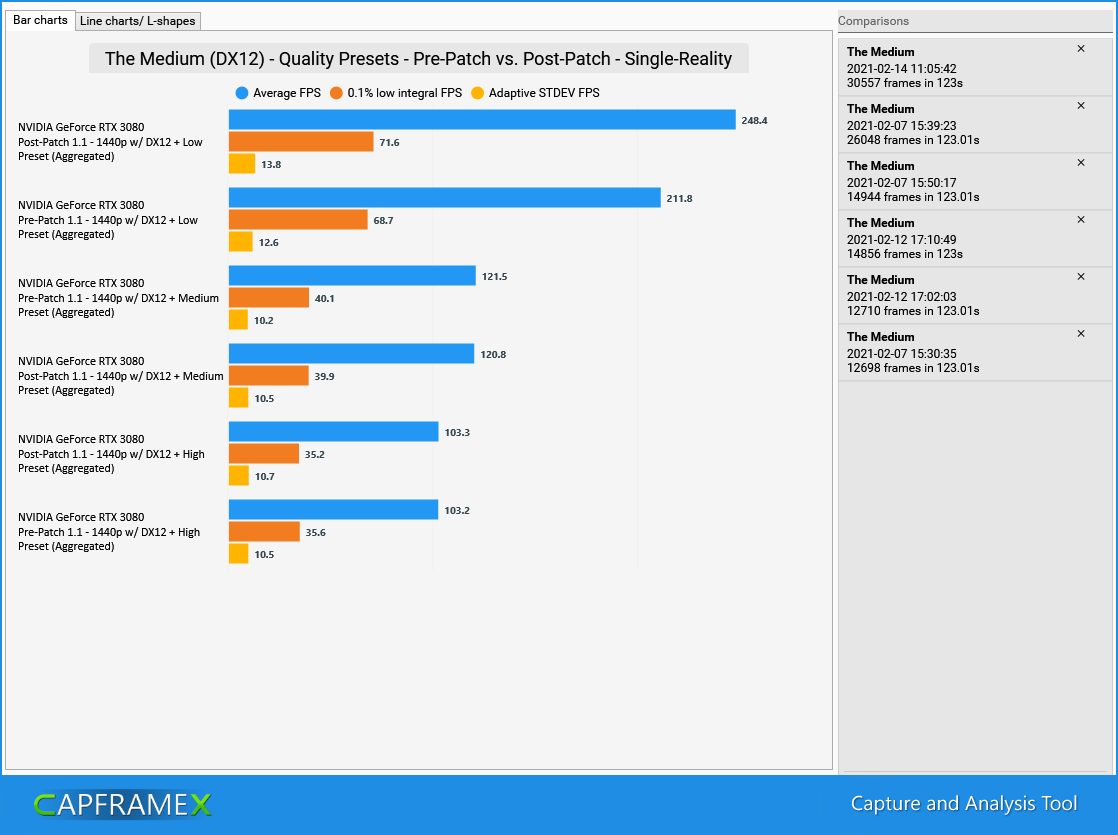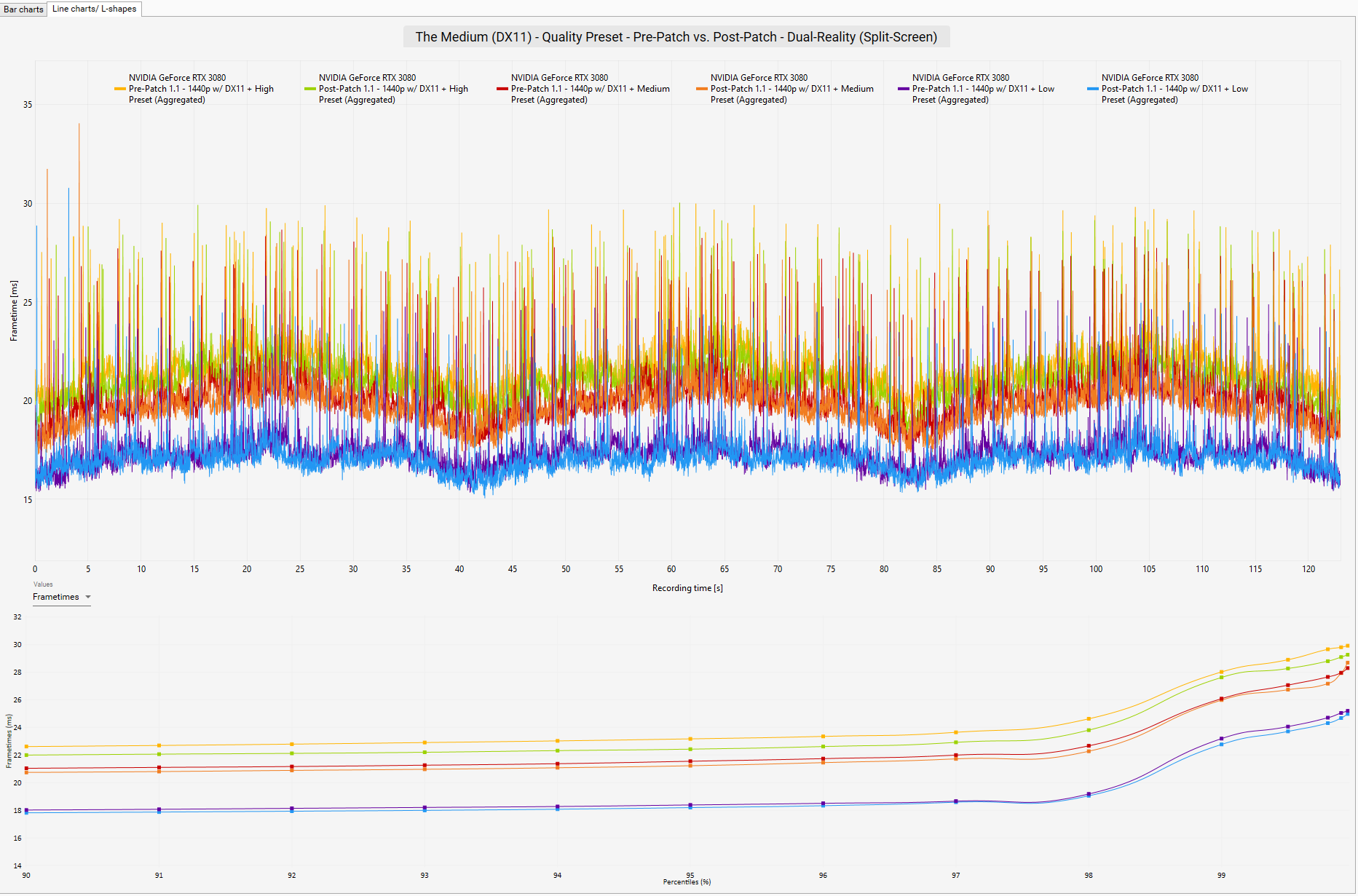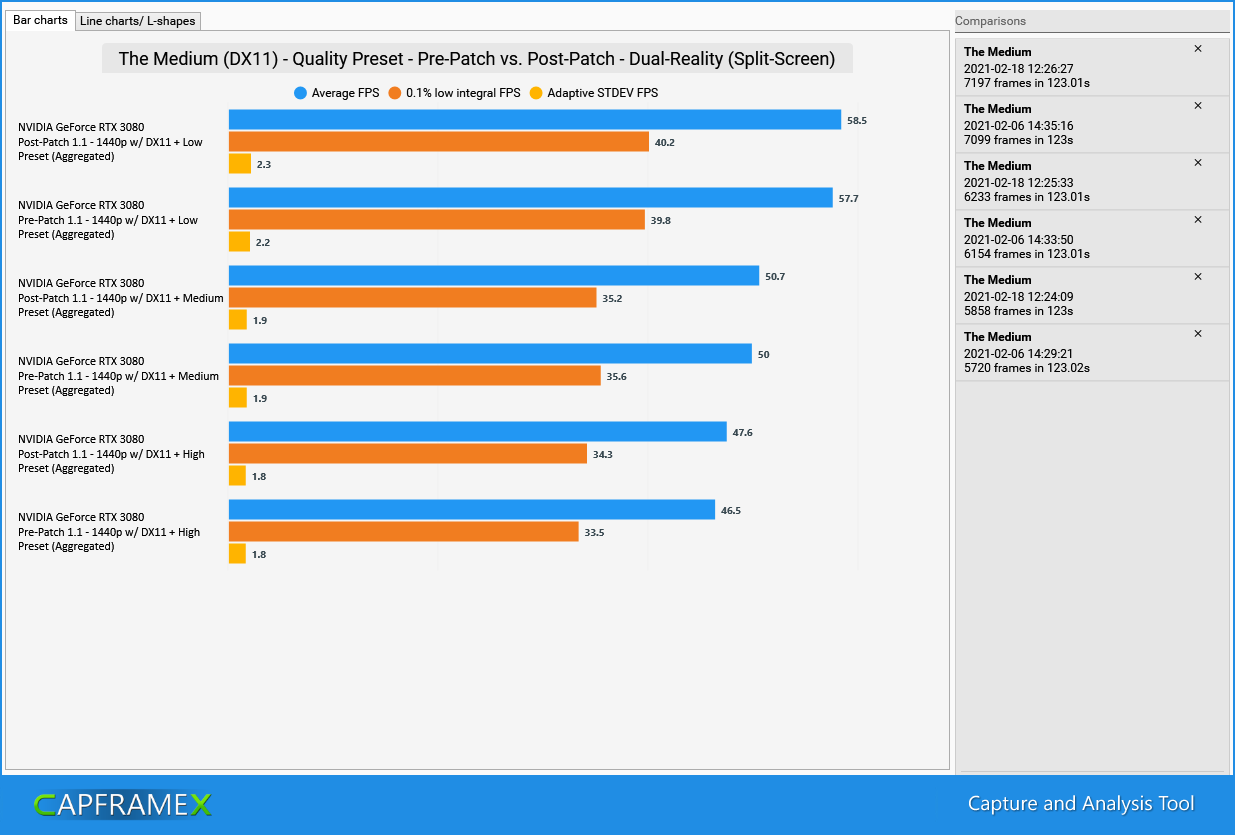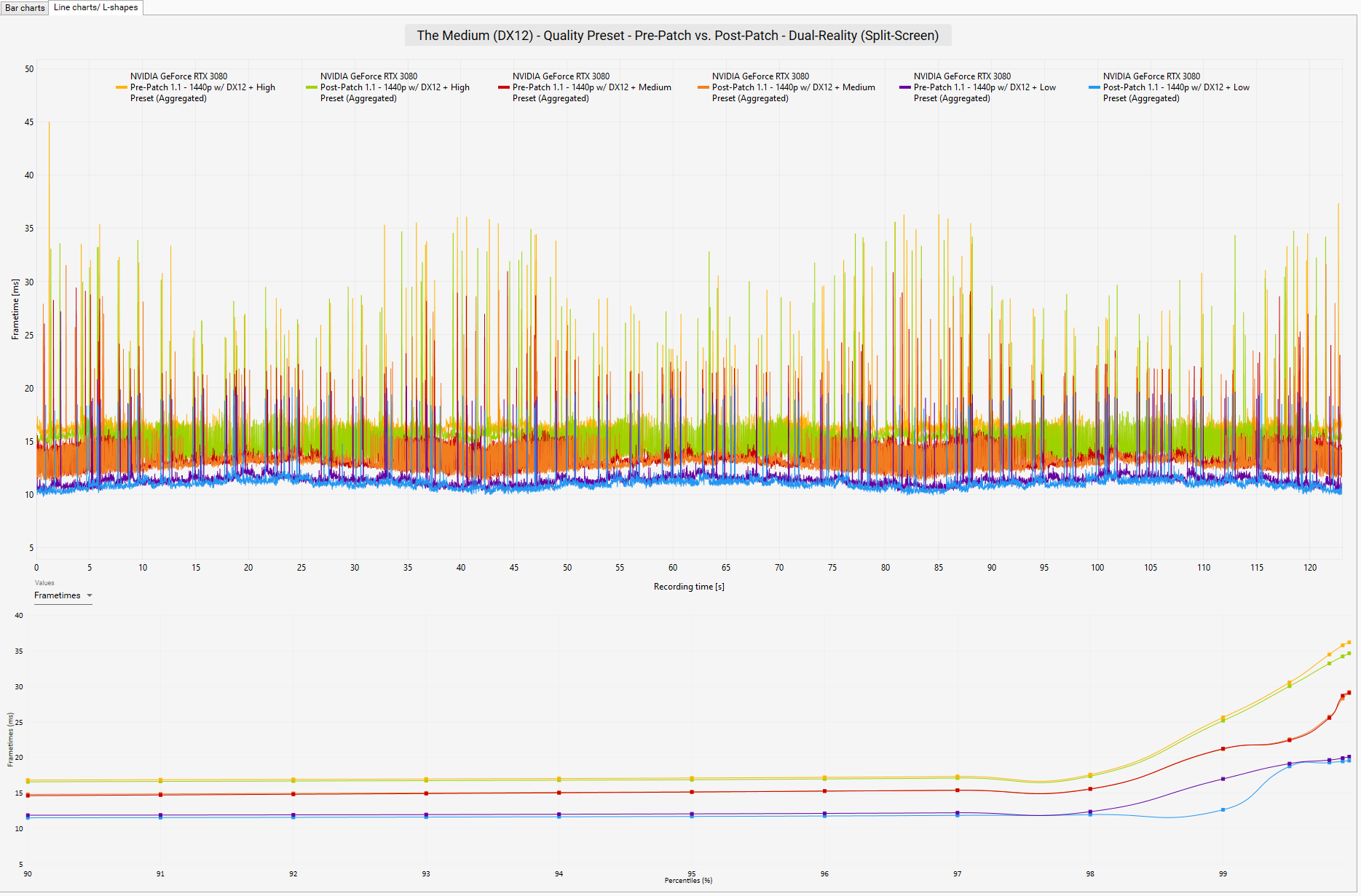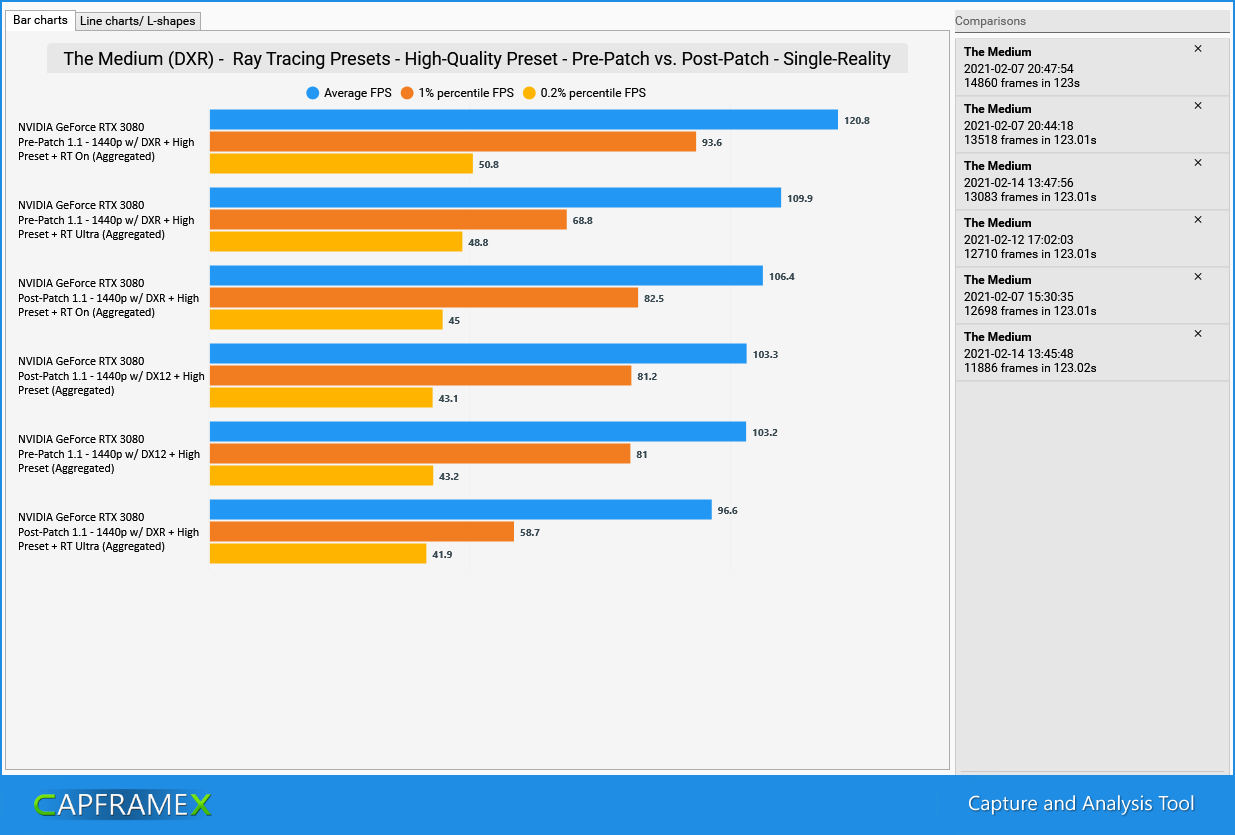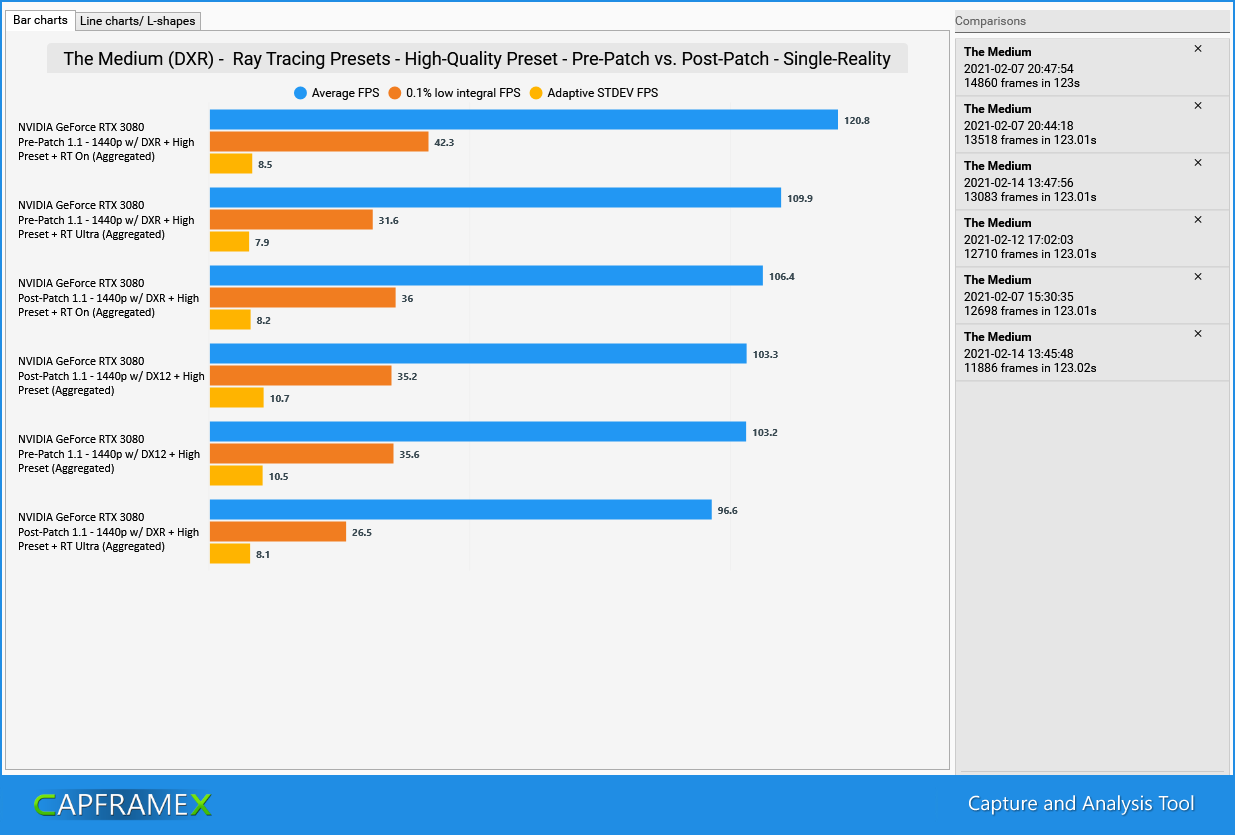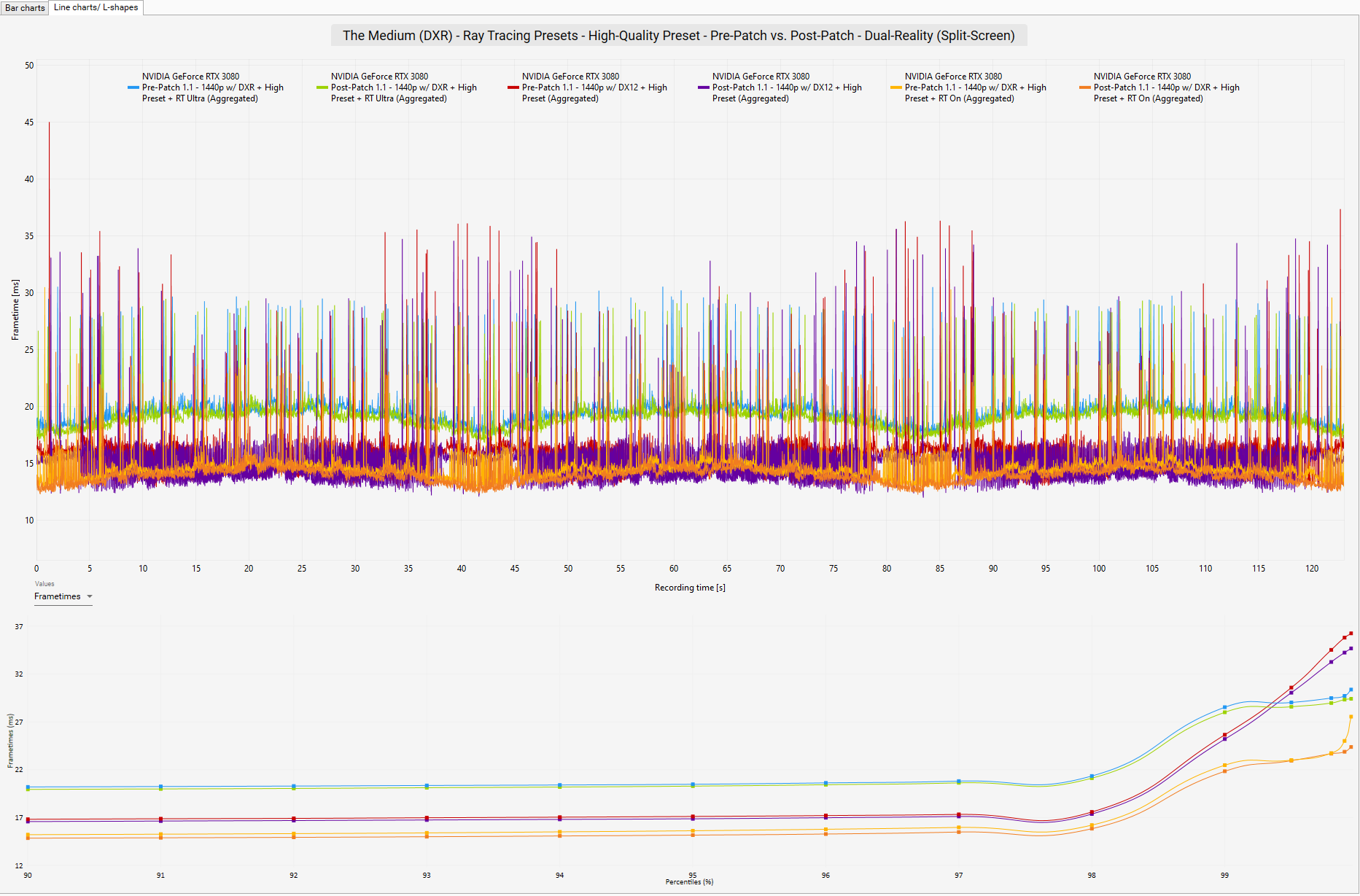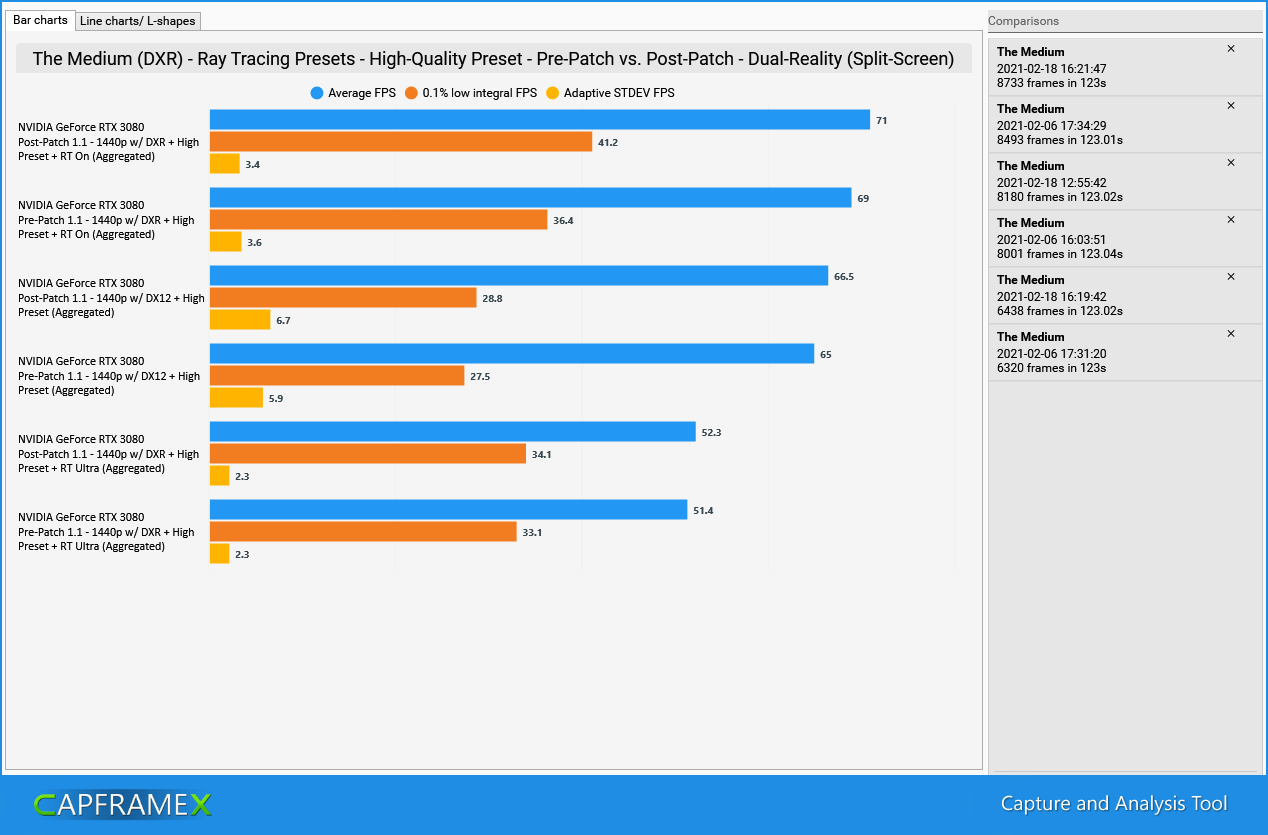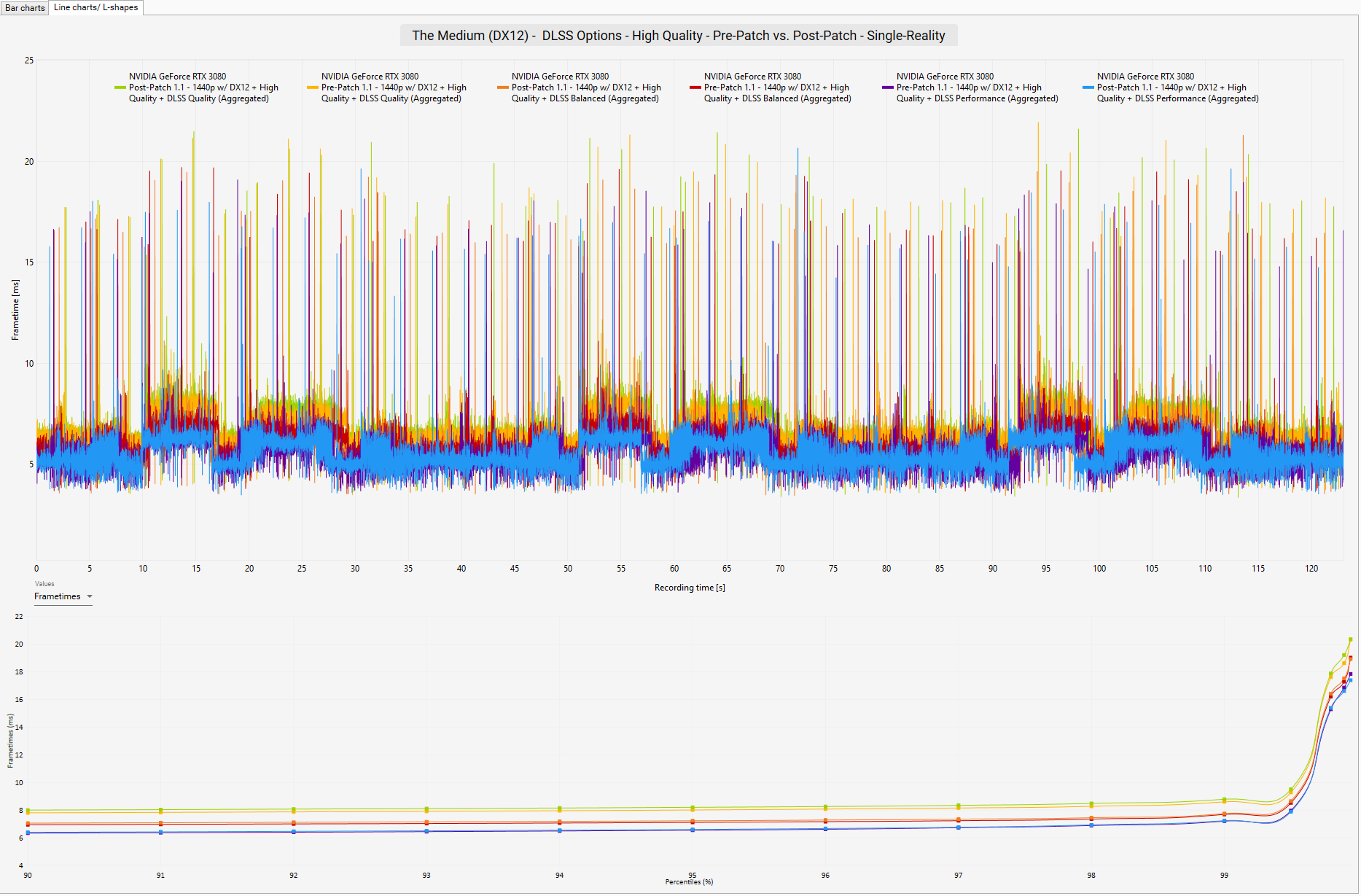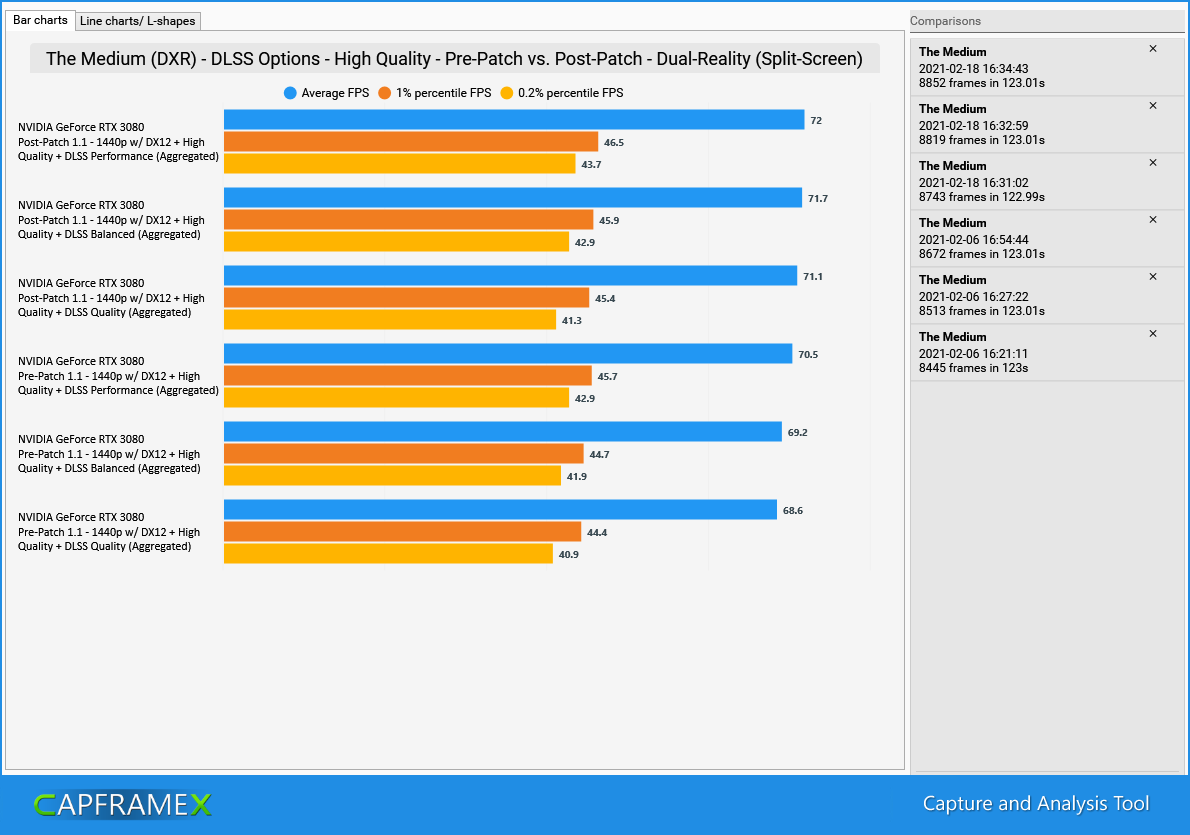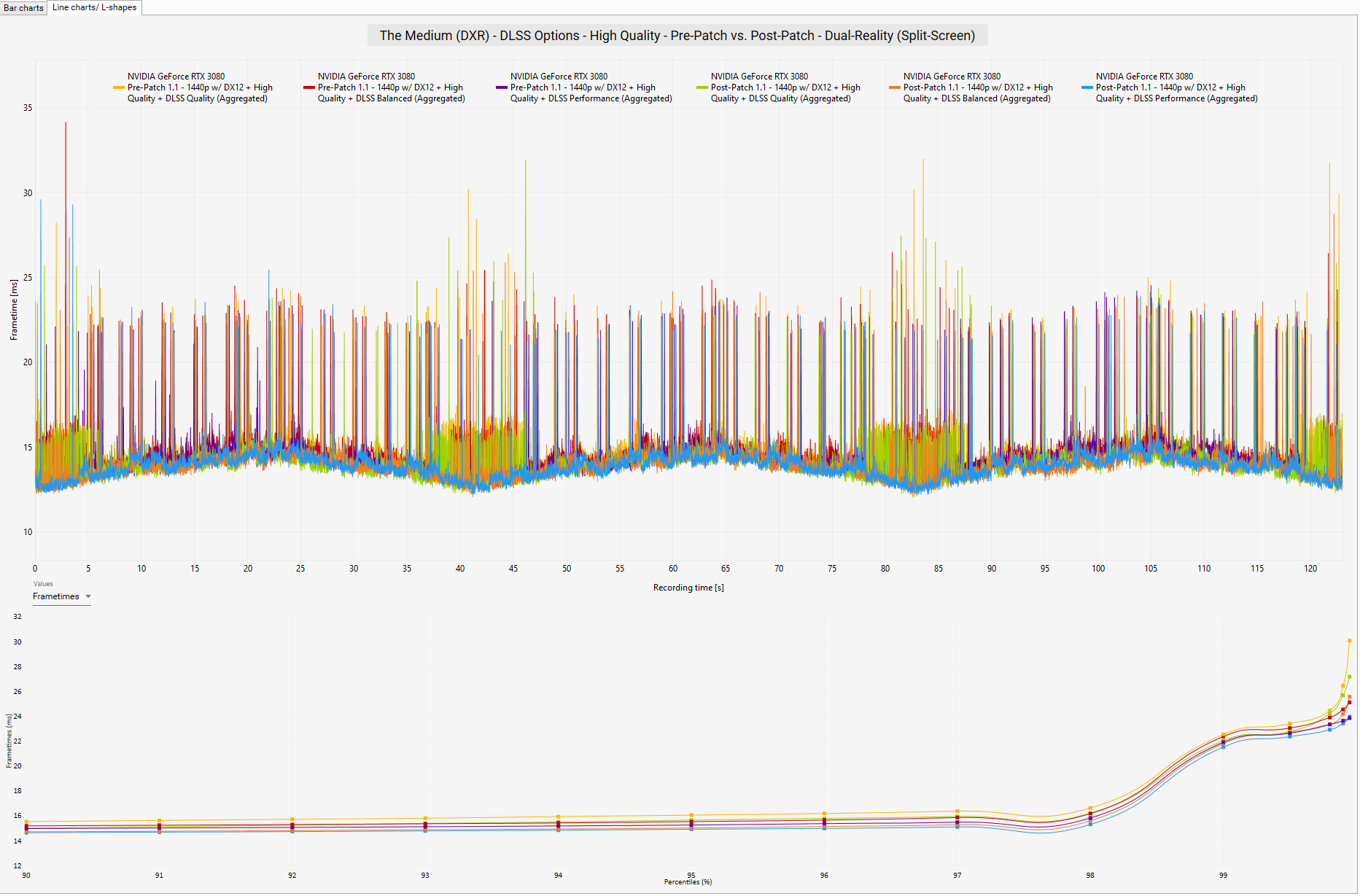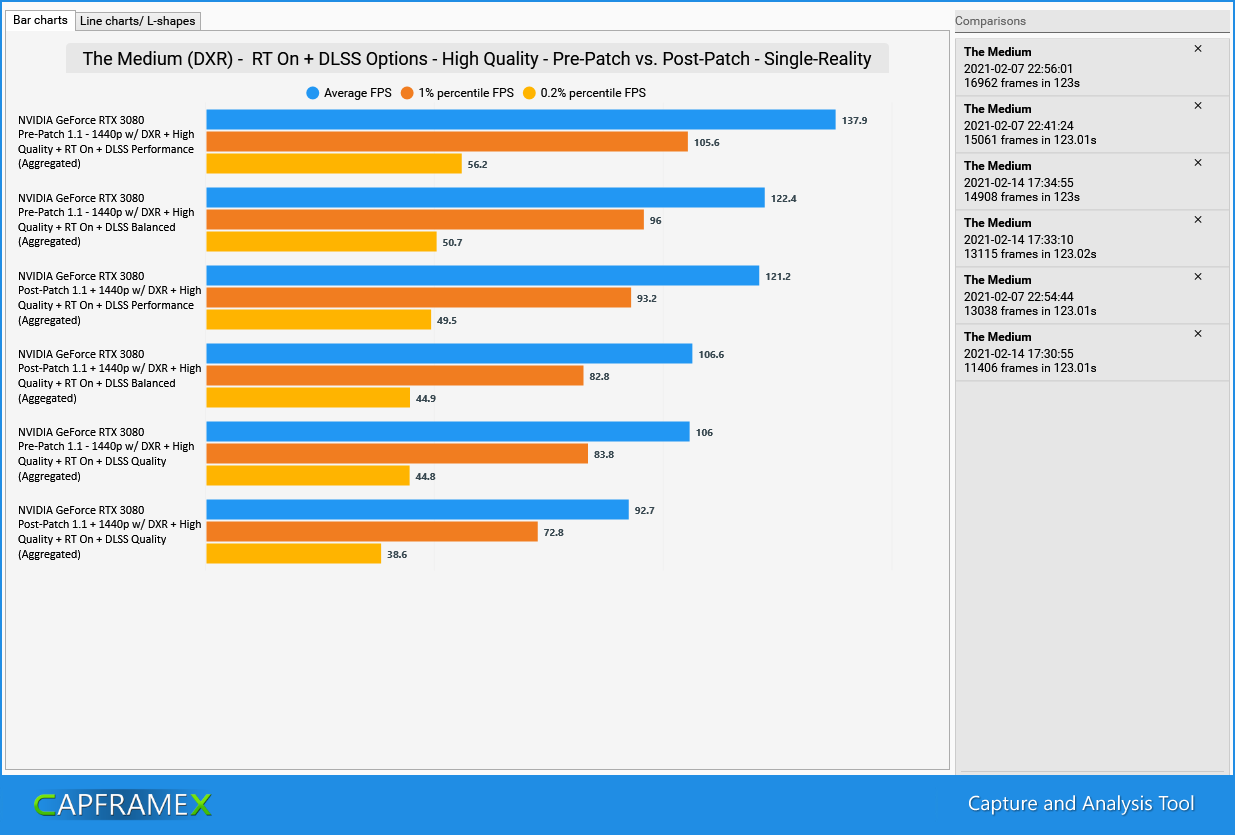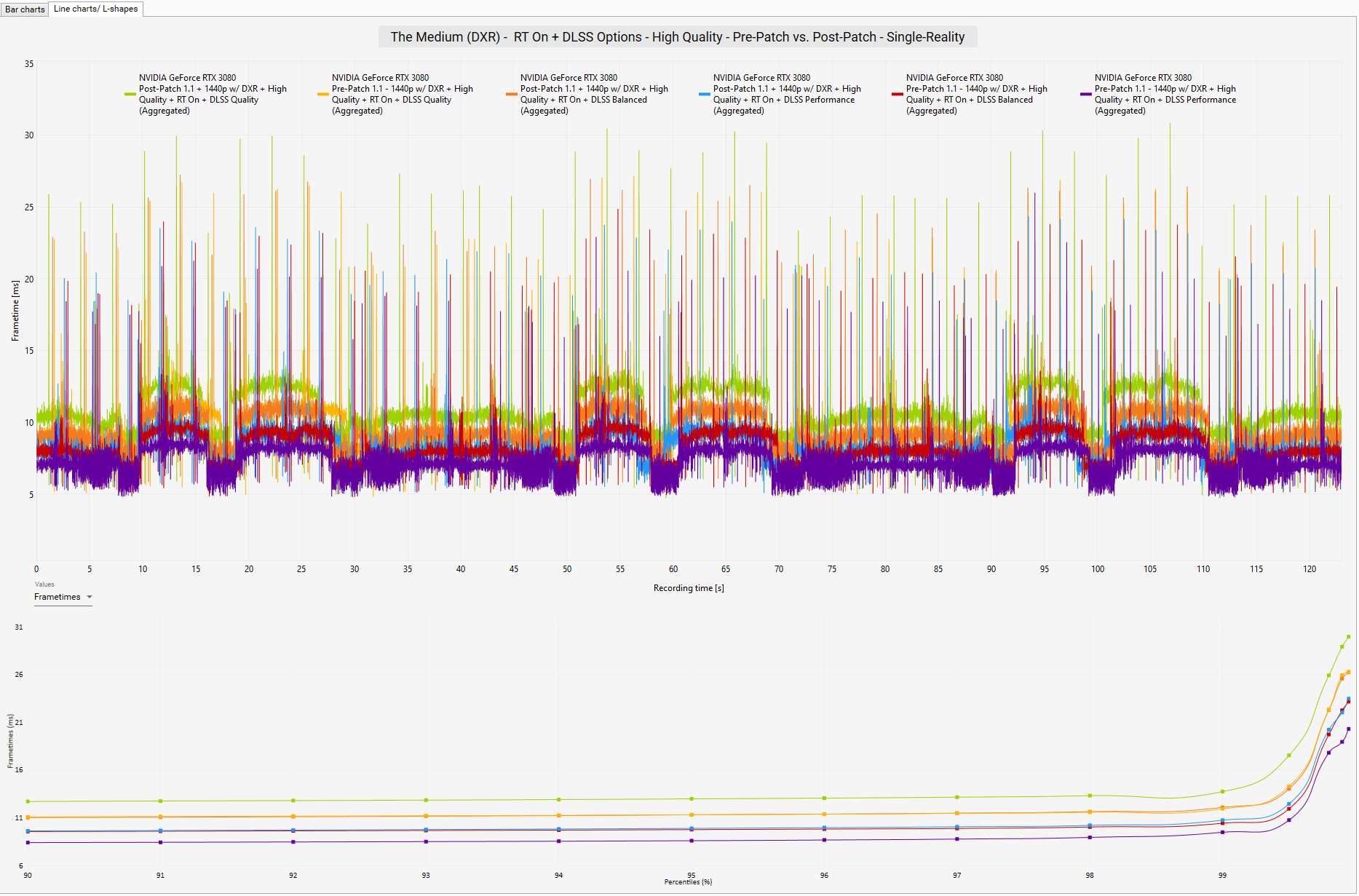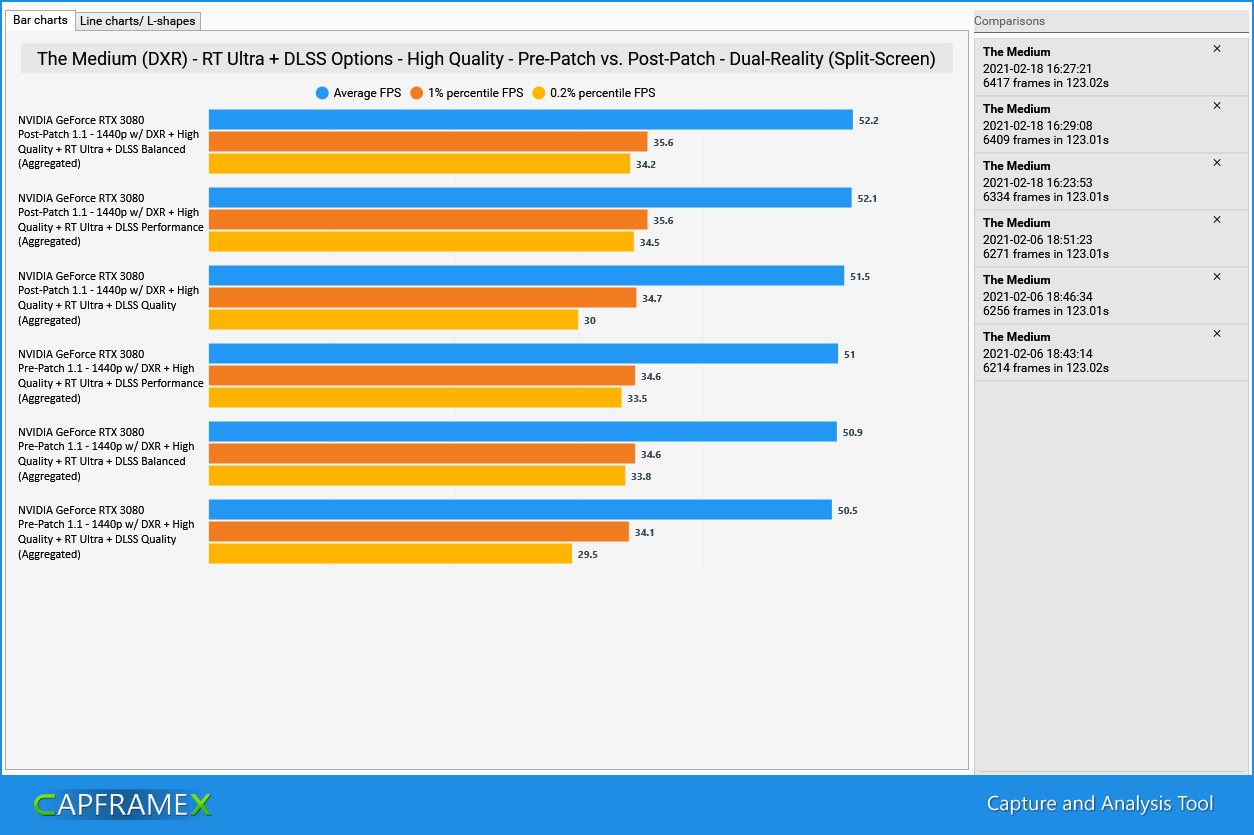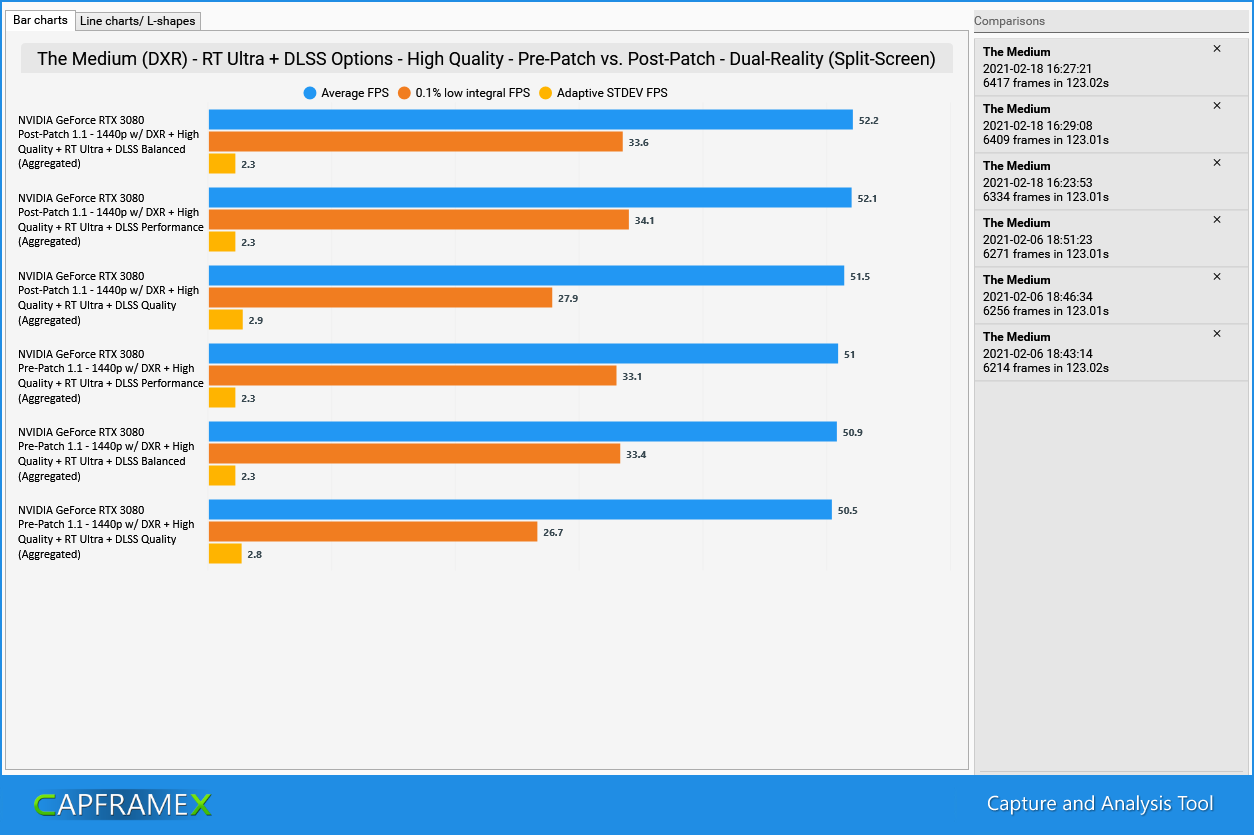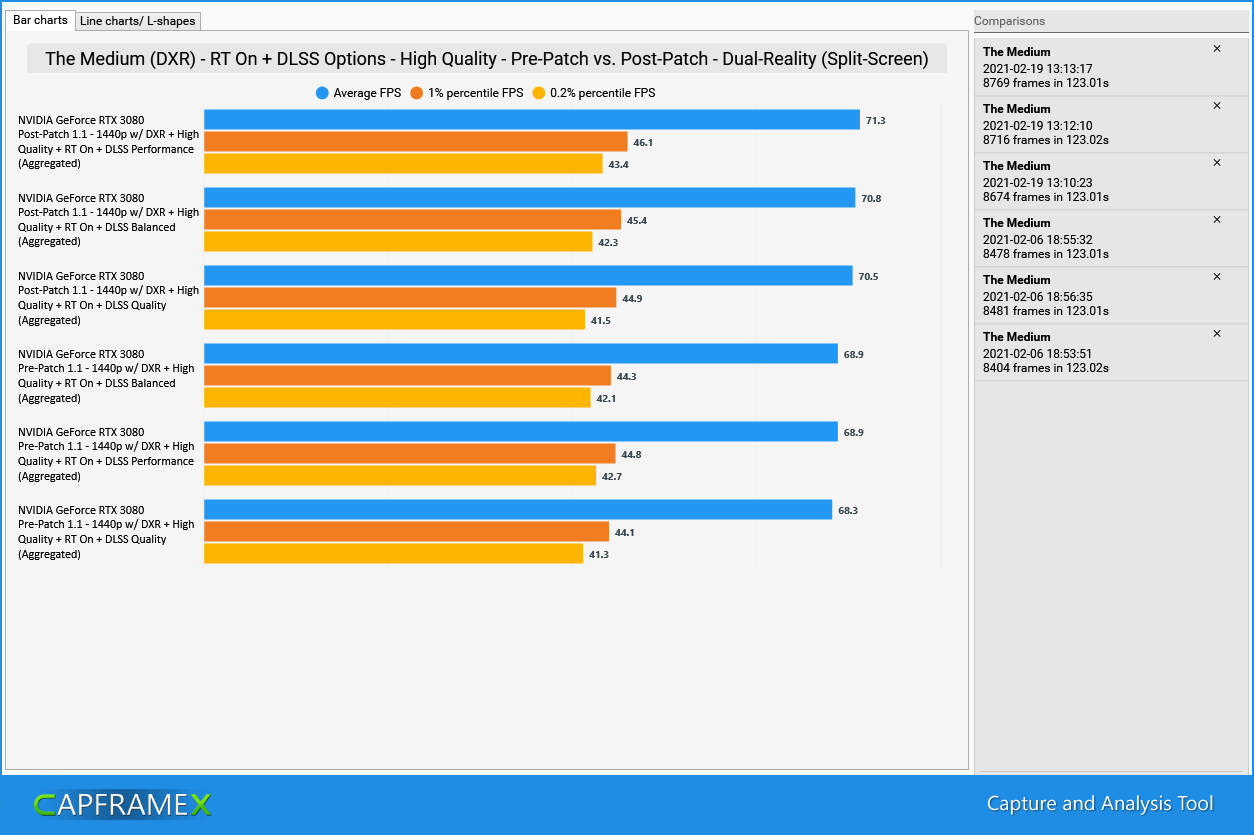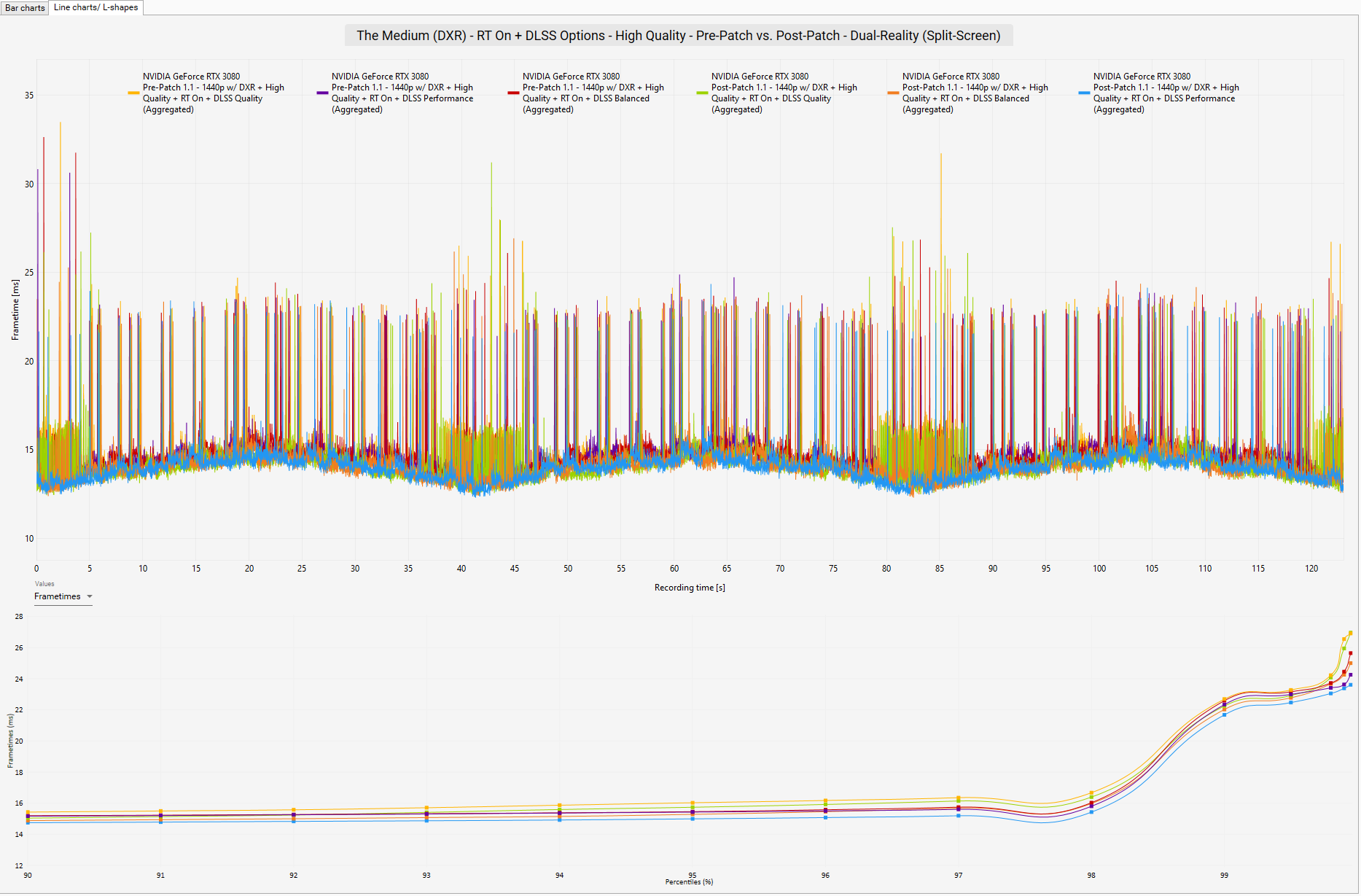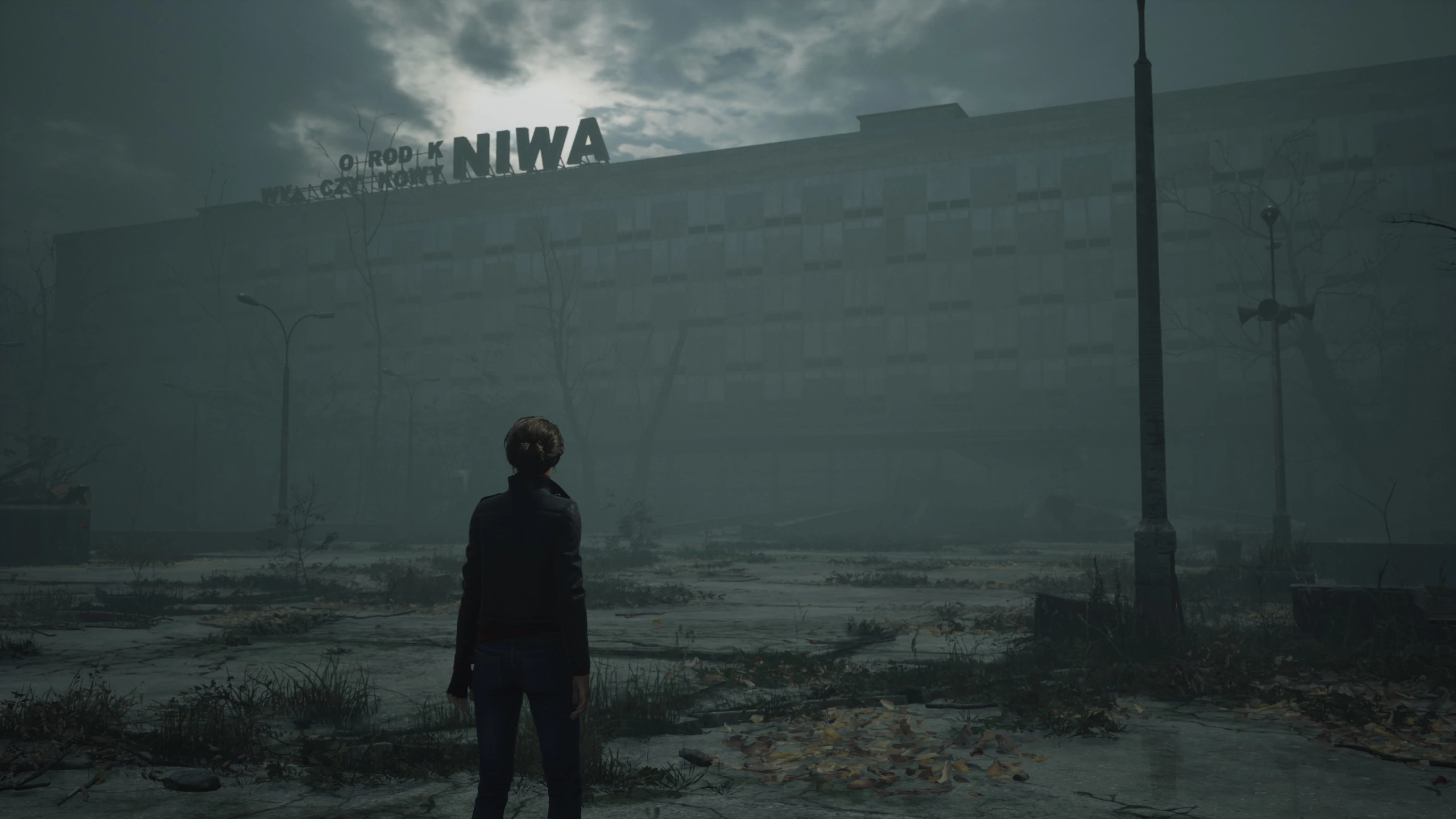‘The Medium’ PC Game Performance and Image Quality Review — Ray tracing and DLSS Settings Benchmarked
The Medium, developed by Bloober Team, arrived three weeks ago for PC. The game uses ray tracing and NVIDIA DLSS technologies to enhance its horrific atmosphere featuring ray-traced reflections, ambient occlusion, and transparent reflections. It recently got updated and reportedly introduced performance improvements, so having an in-depth review of the expected and current performance of The Medium on PC is relevant.
We offer a review of The Medium‘s graphics performance pre and post-Patch 1.1, using its Game-Ready driver with a high-end gaming PC using 1440p resolution. Besides, we show image quality (IQ) comparisons of its quality presets and RTX settings. We make suggestions for getting the best game’s graphics performance and discuss the effects of using ray tracing and DLSS features.
The Game
The Medium is Bloober Team’s most ambitious and innovative video game to date. It is a third-person narrative adventure game with psychological horror elements.
We play as Marianne, a young woman with the rare ability to experience the spiritual dimension and contact the spiritual entities that inhabit it. The adventure begins the hardest-day of her life with a phone call from an unknown man. In that call, the man asks us for help, and that we meet him on an abandoned vacation resort, Niwa. The man claims to know the dream that repeats and disturbs Marianne since childhood and to be able to answer all our questions if we meet him in that abandoned and mysterious location.
From here, Marianne will have to gradually discover the secrets that this dilapidated place still holds and its possible connection with the dream that haunts her and with the man who called her. Of course, this journey and investigation will not be without dangers and frights, that the protagonist will have to face making use of her abilities as a medium through a dual experience of reality. These abilities allow her to interact with both the material and spiritual dimensions of reality.
We liked The Medium in terms of plot, innovative gameplay, music, and art design. However, the subpar and troublesome graphics performance devalues the final experience. We recommend The Medium, but its graphics performance flaws – even after patch 1.1 – really disappointed us.
The Game Graphics Settings
Here are the settings that we used for benchmarking:
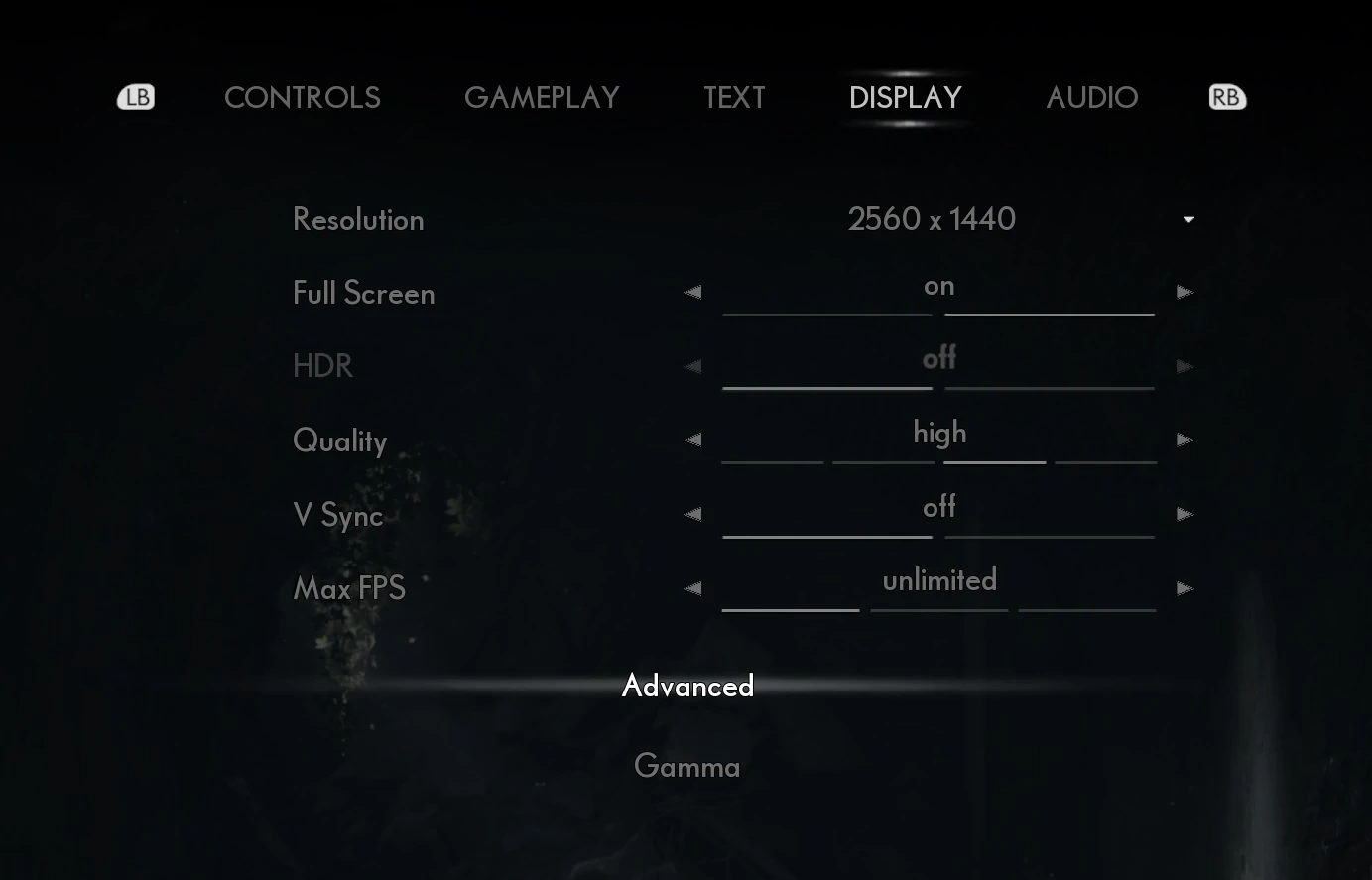
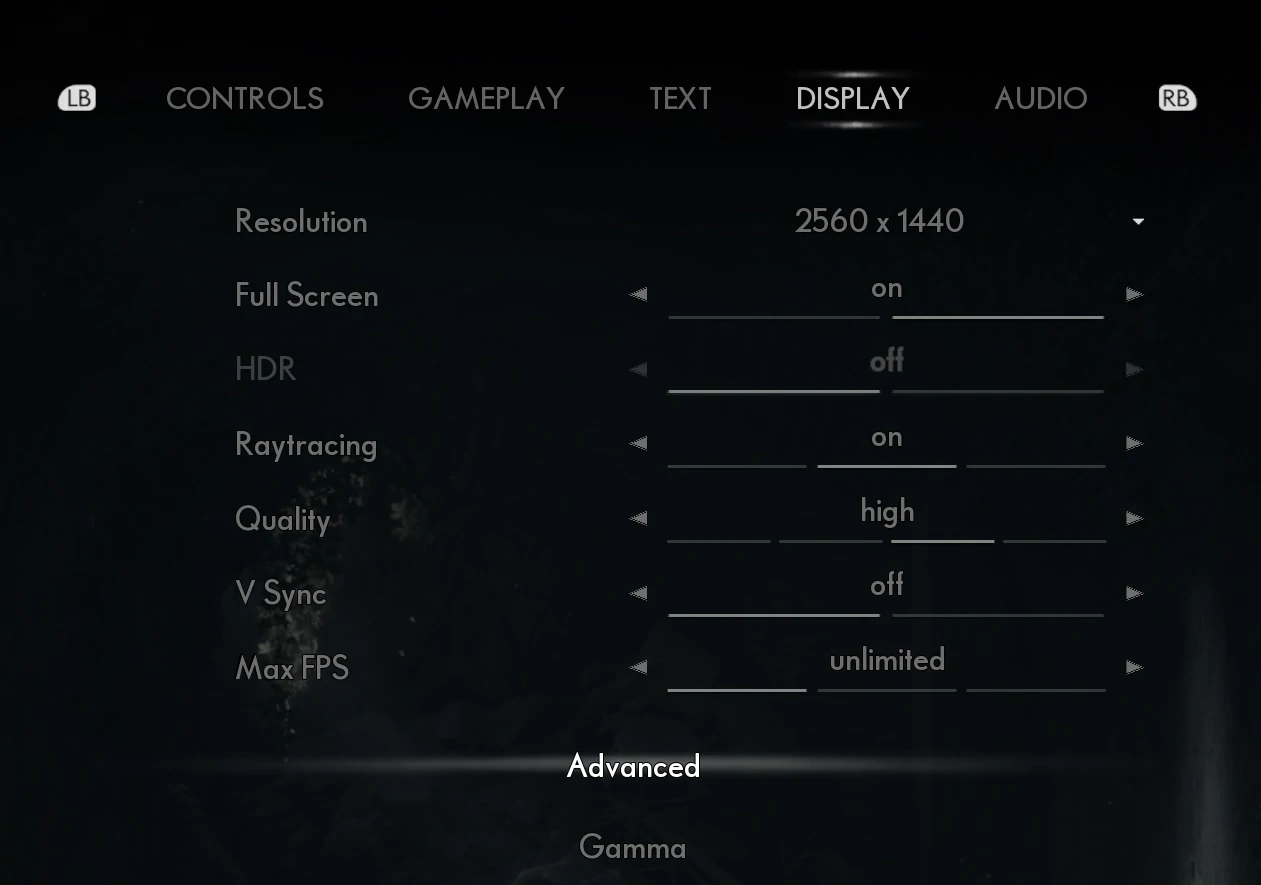
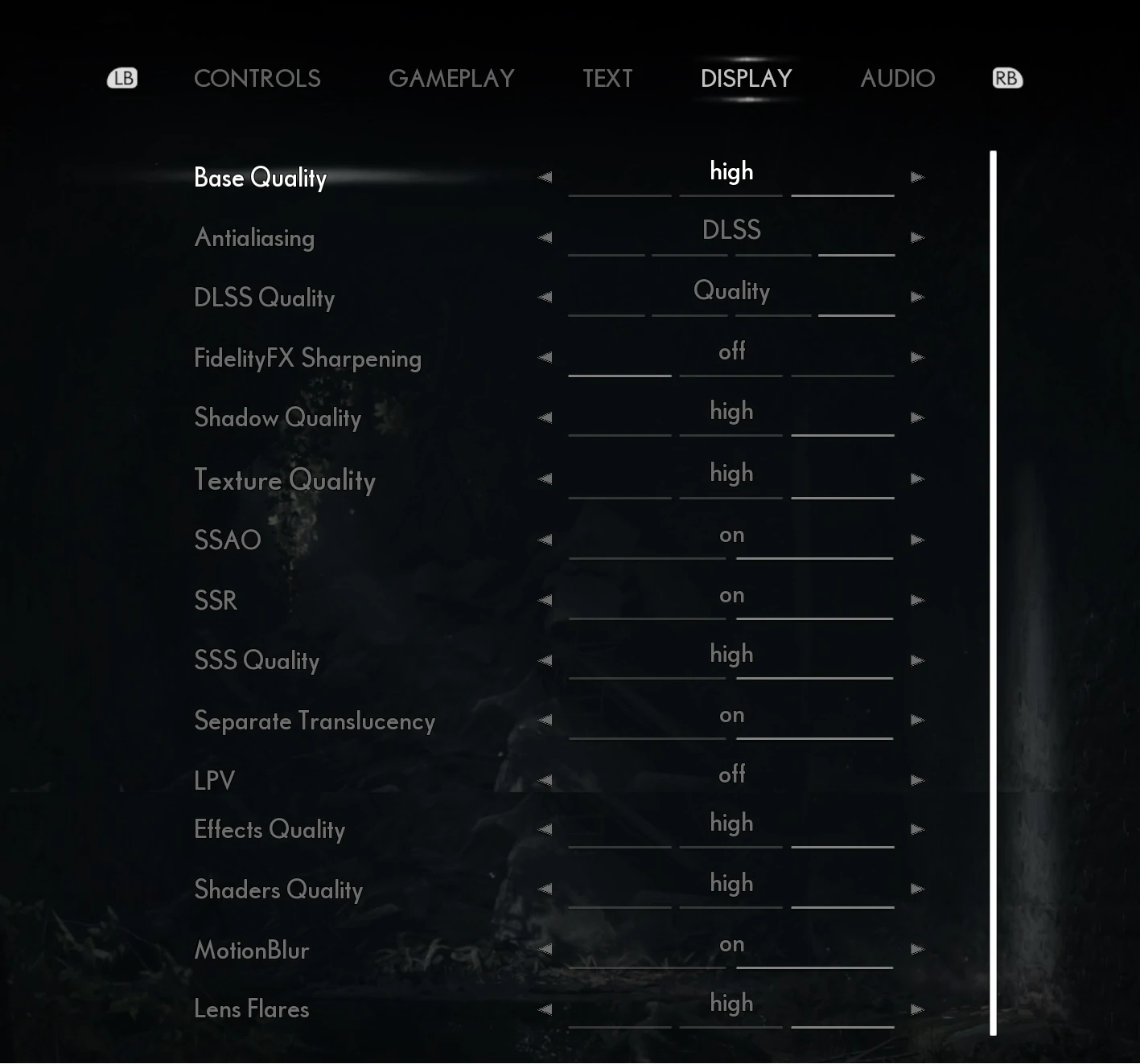
But before offering the game’s performance data and charts of each different analysis scenario, it’s important to describe both the hardware and software configuration used in our testing as well as its analysis methodology on the next page.
Benchmarking Methodology
Test Configuration – Hardware
- Intel Core i9-9900K (Hyper-Threading/Turbo boost on; stock settings)
- Gigabyte Z390 AORUS PRO motherboard (Intel Z390 chipset, v.F9 BIOS)
- Kingston HyperX Predator 32GB DDR4 (2×16GB, dual-channel at 3333 MHz CL16)
- Gigabyte AORUS GeForce RTX 3080 MASTER 10GB (rev. 1.0); v.F2 VBIOS, stock clocks
- Samsung 500GB SSD 960 EVO NVMe M.2
- Corsair RM750x, 750W 80PLUS Gold power supply unit
- ASUS ROG Swift PG279Q 27? IPS 2560 x 1440 165Hz 4ms G-Sync Monitor (G-Sync off, Fixed Refresh Rate on)
Test Configuration – Software
- NVIDIA GeForce 461.40 drivers; ‘high-quality’ and ‘prefer maximum performance’; fixed refresh rate (globally).
- V-Sync application controlled in the control panel, V-Sync off in-game.
- AA and AF controlled by the application, set according to video quality game presets
- Windows 10 64-bit Pro edition, latest updates v20H2, High-performance power plan, Game Mode, Game DVR & Game Bar features off.
- GIGABYTE tools not installed.
- Latest DirectX
- CapFrameX (CX), the latest version
- RivaTuner Statistics Server (RTSS), latest version
Custom Scene Benchmark-related
- We use two different custom scenes to benchmark the game’s graphics performance in single-reality and dual-reality scenarios:
- Single-reality: First three rooms walk-through (recording time, 41 seconds).
- Dual-reality (split-screen): Corridor to Dayroom walk-through (recording time, 41 seconds).
Frametimes Capture & Analysis tool-related
- CapFrameX is used for capturing and analyzing the relevant performance numbers obtained from each recorded custom benchmark scene.
- Consecutive runs until detecting 3 valid runs (no outliers) that can be aggregated by CapFrameX using the following method:
- ‘Aggregate excluding outliers’:
- Outlier metric: Third, P0.2 (0.2% FPS percentile).
- Outlier percentage: 3% (the % the FPS of an entry can differ from the median of all entries before counting as an outlier).
- ‘Aggregate excluding outliers’:
- We compare and value the results and aggregated records in terms of performance gain/loss, by looking at the following metrics:
- Avg FPS
- P1/P0.2/0.1% Low integral FPS
- Adaptive STDEV (the standard deviation of values compared to moving average) as an additional or alternative criterion when valuing frame times consistency.
Let’s head to our performance charts.
WQHD (1440p) — The Medium Pre-Patch 1.1 vs. Post-Patch 1.1 Performance Review
Next, we review The Medium‘s pre-patch 1.1 and post-patch 1.1 performance using the 2560×1440 (1440p) or WQHD display resolution, which is the native resolution of the G-Sync monitor used to conduct this performance analysis.
The performance charts below compare the performance of the game’s quality presets using DX11 and DX12 modes, ray tracing performance, and DLSS using DX12. We show average FPS numbers for the raw performance; and P1, P0.2, and 0.1% low integral values for frametime stability. We use the adaptive STDEV metric as an additional or alternative criterion to evaluate frametime consistency.
Each graphics quality preset and RTX setting are tested on both single-reality and dual-reality (split-screen) scenarios.
Quality Presets Performance — High, Medium, and Low
Single-Reality Scenario
DirectX 11 and DirectX 12
DirectX 11 Mode
In this single-reality and DirectX 11 scenario, the only quality preset showing an improvement in raw performance after the patch is Low. The rest don’t improve in terms of average FPS and perform the same overall.
From the graphs, we see how, despite the improvement in P0.2 using the low-quality preset, the consistency of frame times worsens in all cases when we take into account the numbers of 0.1% low integral and adaptive STDEV after applying the patch.
DirectX 12 Mode
From the chart, we see that the only quality preset showing a better raw performance after the patch is Low. The rest don’t improve in terms of average FPS and perform the same overall.
We see that the frametime consistency is overall the same using High and Medium presets when we look at 0.1% low integral and adaptive STDEV metrics. However, the Low preset is also less stable after the patch in this scenario.
Please, note that in this single-reality scenario, the game performs better overall when using DX11 than DX12. However, both API modes present notable frame pacing, hitching, and stuttering issues.
Dual-Reality (Split-Screen) Scenario
DirectX 11 and DirectX 12
DirectX 11 Mode
In this split-screen and DX11 scenario, we found no significant performance differences in all cases after the patch in terms of average FPS.
From the charts, we see that frametime consistency is overall the same after the patch in this DX11 dual-reality scenario.
DirectX 12 Mode
In this scenario, we found that the only quality preset that showed a better raw performance post-patch was Low. The rest didn’t improve in terms of average FPS and performed the same overall.
From the graphs, while we see an improvement in P1 using the low-quality preset, High and Medium were less stable considering their corresponding 0.1% low integral and adaptive STDEV values after the patch.
Note that in this dual-reality scenario, the game performs smoother overall when using DX11 than DX12, but the raw performance is significantly lower using DX11 than DX12. That said, both API modes still show severe frame pacing, hitching, and stuttering issues in this scenario.
Ray Tracing Presets Performance — Ultra, and On
Single-Reality Scenario
In this single-reality and DXR scenario, we see a significantly better raw performance pre-patch than post-patch using all the ray tracing presets.
Note that, paradoxically, high-quality without ray tracing performs worse than high-quality with RT-On in terms of average FPS.
From the charts, we see that the high-quality preset with RT-on is smoother after the patch, but the high preset with RT-ultra performs worse in terms of frametime consistency after the patch.
Dual-Reality (Split-Screen) Scenario
Although the charts above show no significant differences in average FPS after the patch in this DXR split-screen scenario, high-quality with RT-on is smoother in terms of frametime consistency after the patch.
DLSS Options Performance — Quality, Balanced, and Performance
DirectX 12 and DLSS
Single-Reality Scenario
We saw no significant performance differences after the patch using all the DLSS options. However, we found a performance increase of ~12% per step and before and after the patch, moving from DLSS Quality to DLSS Performance.
In this scenario, we only saw a worse frametime consistency when using high-quality with DLSS-performance.
Dual-Reality (Split-Screen) Scenario
From the charts, we overall see the same post-patch performance when using high-quality with each DLSS option.
Also, note that the gains of using DLSS are always minor in the split-screen scenario, which is quite disappointing.
Ray Tracing Pres ets and DLSS
Single-Reality Scenario
RT Ultra and DLSS
In this scenario, we found regressions in both raw performance and frametime consistency using each DLSS option after applying the patch.
RT On and DLSS
From the charts, we also see both worse raw performance and frametime stability after the patch using each DLSS option with RT enabled and high-quality settings.
Note that the performance gains, in this single-reality scenario, when using high-quality with DLSS compared to high without DLSS were overall negligible.
Dual-Reality (Split-screen) Scenario
RT Ultra and DLSS
RT On and DLSS
From the charts, we see that while post-patch raw performance was slightly better in these testing scenarios, frametime stability was overall significantly worse in all cases after the patch.
Also, note that the performance gains, in this split-screen scenario, when using high-quality with DLSS compared to high without DLSS were overall negligible.
Let’s see our IQ comparisons.
The Medium IQ Comparisons
Next, we will perform some relevant dual comparisons between graphics game presets that will allow us to identify the recommended and most balanced presets in terms of performance/IQ when moving from a lower to higher quality preset.
Quality Presets — High , Medium, and Low
Here is the Low-Quality preset (low) compared with the Medium-Quality preset (medium).
[twenty20 img1=”21990″ img2=”21991″ offset=”0.5″ before=”Low-Quality” after=”Medium-Quality”]
Look at the Low-Quality preset (low) compared with Medium-Quality preset (medium) from a different location.
[twenty20 img1=”21995″ img2=”21996″ offset=”0.5″ before=”Low-Quality” after=”Medium-Quality”]
The change from ‘Low-Quality’ (low) to ‘Medium-Quality’ (medium) is probably the most noticeable improvement among the presets in terms of IQ.
Now, let’s see the Medium-Quality preset (medium) compared with the High-Quality preset (high).
[twenty20 img1=”21991″ img2=”21994″ offset=”0.5″ before=”Medium-Quality” after=”High-Quality”]
Here is the Medium-Quality preset (medium) compared with the High-Quality preset (high) from a different room.
[twenty20 img1=”21996″ img2=”21997″ offset=”0.5″ before=”Medium-Quality” after=”High-Quality”]
This is the case where the difference in image quality between the presets is the least noticeable. There is not much difference between the two presets in IQ.
We recommend using the Medium-Quality preset if you want to boost your average FPS while preserving good image quality.
Ray Tracing Presets — Ultra, and On
Here are some relevant dual comparisons between ray tracing presets combined with the high-quality preset that will allow us to identify the recommended and most balanced RT preset in terms of performance/IQ when moving from RT-on to RT-ultra preset.
[twenty20 img1=”22018″ img2=”22019″ offset=”0.5″ before=”High-Quality – RT Off” after=”High-Quality – RT On”]
[twenty20 img1=”22019″ img2=”22017″ offset=”0.5″ before=”High-Quality – RT On” after=”High-Quality – RT Ultra”]
Look at some dual comparisons between RT presets with the high-quality preset from a different room.
[twenty20 img1=”22023″ img2=”22024″ offset=”0.5″ before=”High-Quality – RT Off” after=”High-Quality – RT On”]
[twenty20 img1=”22024″ img2=”22022″ offset=”0.5″ before=”High-Quality – RT On” after=”High-Quality – RT Ultra”]
Here are other dual comparisons between RT presets with the high-quality preset from another location.
[twenty20 img1=”22026″ img2=”22027″ offset=”0.5″ before=”High-Quality – RT Off” after=”High-Quality – RT On”]
[twenty20 img1=”22027″ img2=”22025″ offset=”0.5″ before=”High-Quality – RT On” after=”High-Quality – RT Ultra”]
For users with DXR-capable GPUs, we recommend using the RT-on preset if you want the best balance between performance and image quality.
DLSS Options — Quality, Balanced, and Performance
DirectX 12 and DLSS
Finally, look at some dual comparisons between DLSS options using DX12 and high-quality settings.
[twenty20 img1=”22037″ img2=”22035″ offset=”0.5″ before=”High-Quality – Native” after=”High-Quality – DLSS Quality”]
[twenty20 img1=”22035″ img2=”22036″ offset=”0.5″ before=”High-Quality – DLSS Quality” after=”High-Quality – DLSS Balanced”]
[twenty20 img1=”22035″ img2=”22038″ offset=”0.5″ before=”High-Quality – DLSS Quality” after=”High-Quality – DLSS Performance”]
‘DLSS Balanced’ is our recommended DLSS option in terms of performance and image quality for RTX users, at least from a 1440p native resolution.
Let’s head to our conclusion.
Final Thoughts
The Medium on PC is a good game overall, but with notable graphics performance flaws. Its gameplay is enjoyable, especially for those players who like a narrative interactive adventure game. We highlight both the use of a third-person perspective with semi-fixed camera angles – in the style of the older Resident Evil or Silent Hill games – and the innovative implementation of synchronous split-screen gameplay, which allows us to interact simultaneously in two different but connected realities.
Probably its main strengths are its interesting mystery plot with remarkable ‘thriller’ and psychological elements. The detailed and beautiful art-design masterfully recreates an immersive horror atmosphere. This immersive atmosphere is also possible thanks to its excellent soundtrack, created by masters Akira Yamaoka and Arkadiusz Reikowski.
However, The Medium‘s graphics performance is one of the worst and weirdest we have seen in a PC video game, showing noteworthy performance flaws, even after applying patch 1.1. In fact, our in-depth performance review clearly shows how the game still suffers from severe frame pacing, hitching, and stuttering issues. Bloober Team has not been able to fix these faults so far, and patch 1.1 not only fails to overall improve graphics performance but significantly worsens it in some cases. This troublesome situation is unacceptable and devalues the game.
Summary – Results and Recommendations
Here is the summary of our main performance results and recommendations:
- There is no absolute superiority of DX11 over DX12. While frametime consistency is notably better when using DX11 mode, DX12 provides a significantly higher average FPS in dual-reality scenarios (split-screen).
- The best and most balanced graphics quality preset in terms of performance (FPS avg. and frametime stability) and image quality is Medium-Quality.
- The best and most balanced ray tracing preset in terms of performance and image quality is RT-On.
- Overall, the best and most balanced DLSS option in terms of performance and image quality is DLSS-Balanced.
- The performance gains from using the DLSS options do not scale well, or even barely, in DXR scenarios.
The Medium is a game we would normally give an 8/10, but its poor performance drags the score down to a 6/10. Wait for another patch or two or pick it up on a sale.
We hope our performance and IQ reviews will be helpful to you. Please comment below.
